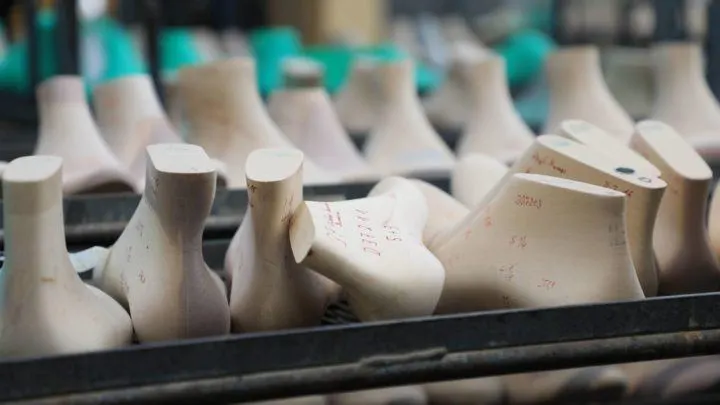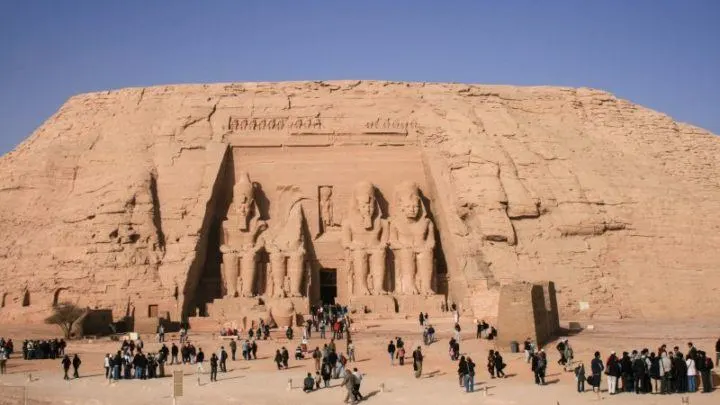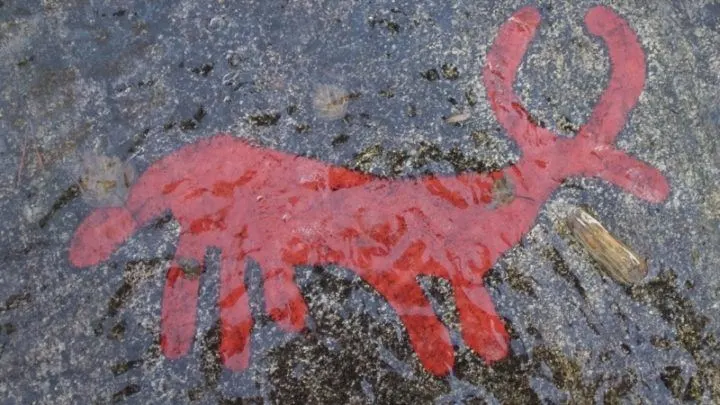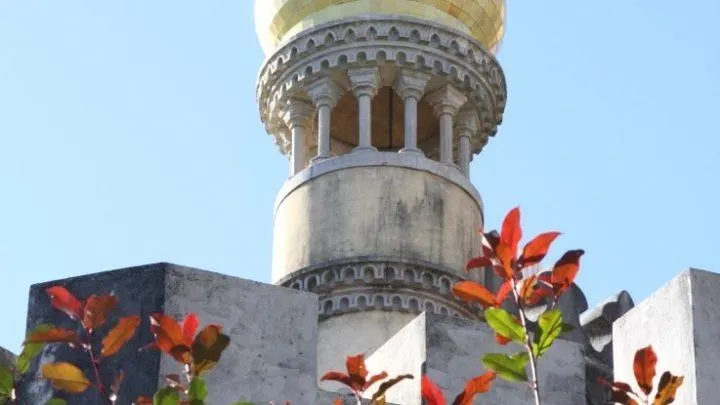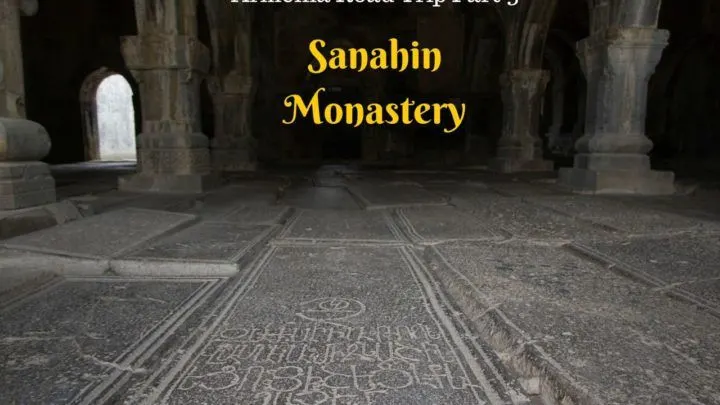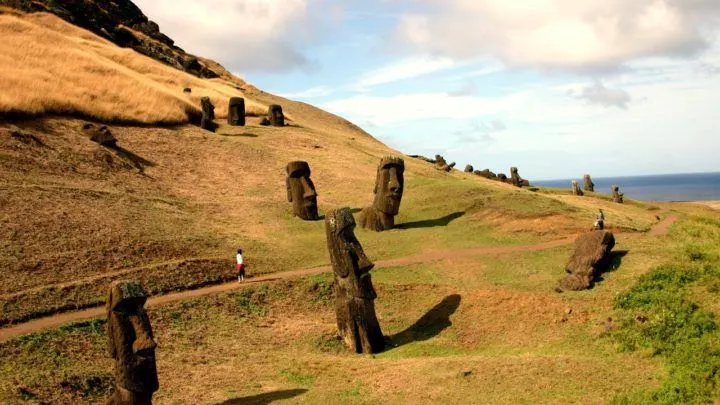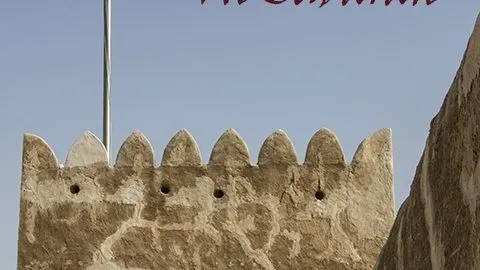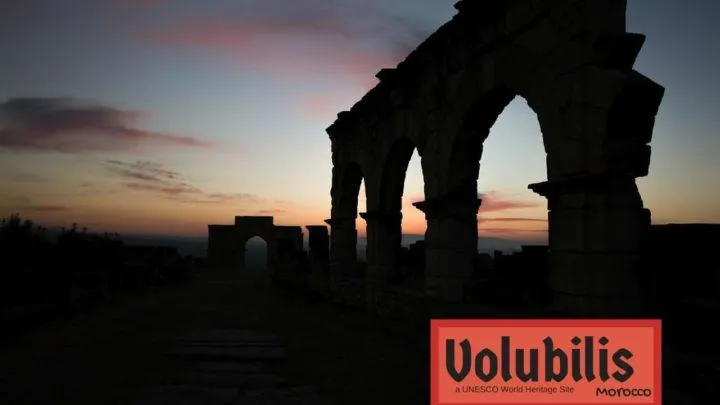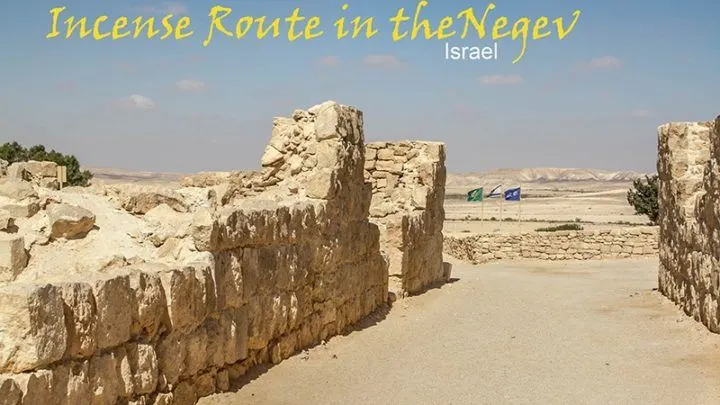France’s world heritage sites highlight all the important sites in the country. If you are planning a trip, and want to include some of them, our list will help you plan and decide which ones to include on your itinerary.
There is so much to see when you travel around the world that it’s sometime hard to figure out where to go. One thing that I’ve learned, in my travel evolution, to do as I plan my trips is check out the UNESCO World Heritage List and see what has been tagged as an important site in the country. Some countries have dozens of world heritage sites (like Spain or China), where others may not have any or only one or two (like in Qatar or Botswana).
After checking out the list, I map them out, see where they are and determine which ones I will actually visit. As you would expect, however, some really lend themselves to tourists and some do not. In fact, some are such popular tourist sites that they then can become endangered due to the amount of people going there. It’s a delicate balance, but one that I think is integral in deciding what I want to spend my travel time on.
The physical country of France has a total of 47 UNESCO World Heritage Sites. There are three more listed as France, but they are far from the mainland. One is New Caledonia, one is Reunion Island in the Indian Ocean, and one is the French Austral Lands near Antarctica. These, needless to say, are pretty hard to visit. However, the ones in mainland France (including Corsica) are much, much easier to reach.
In this article, I’ve asked some fellow travelers which France world heritage sites they have been to. Together we’ve written about many but not all of them, so that while you are planning your trip to France, you can pick the world heritage sites that appeal to you. While planning your trip, you can see where they are on the map, then check to see what we think of them, and hopefully add some amazing sites to your France itinerary.
Map of France’s Best World Heritage Sites
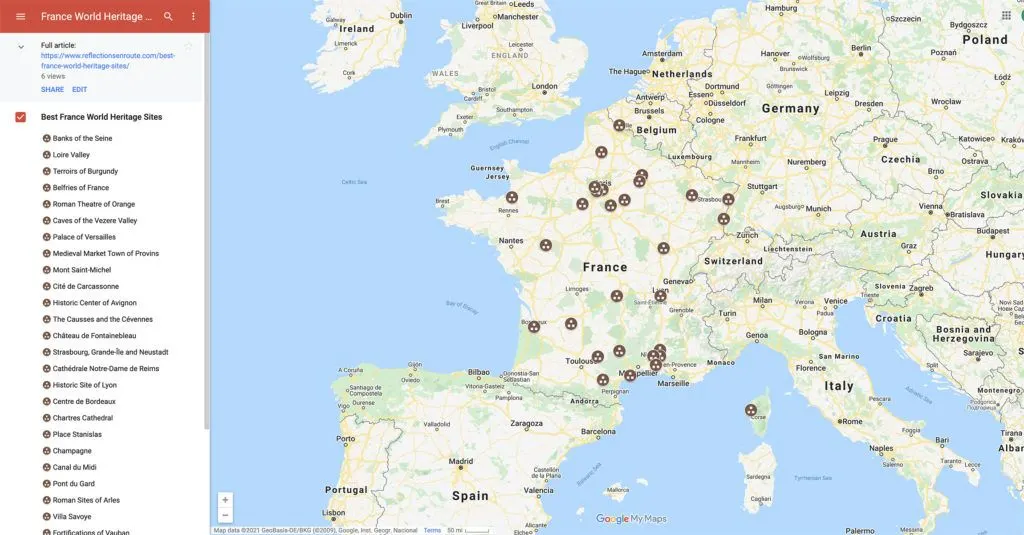
Here is a list of the world heritage sites in France that you might like to visit:
Note: We’ve added the UNESCO list number associated with each site if you want to read the formal reason why it has been inscribed as an important global site. To go to it, just type in “https://whc.unesco.org/en/list/#/”. Many of these sites are grouped in areas we love to visit, some of our best places in France, in fact.
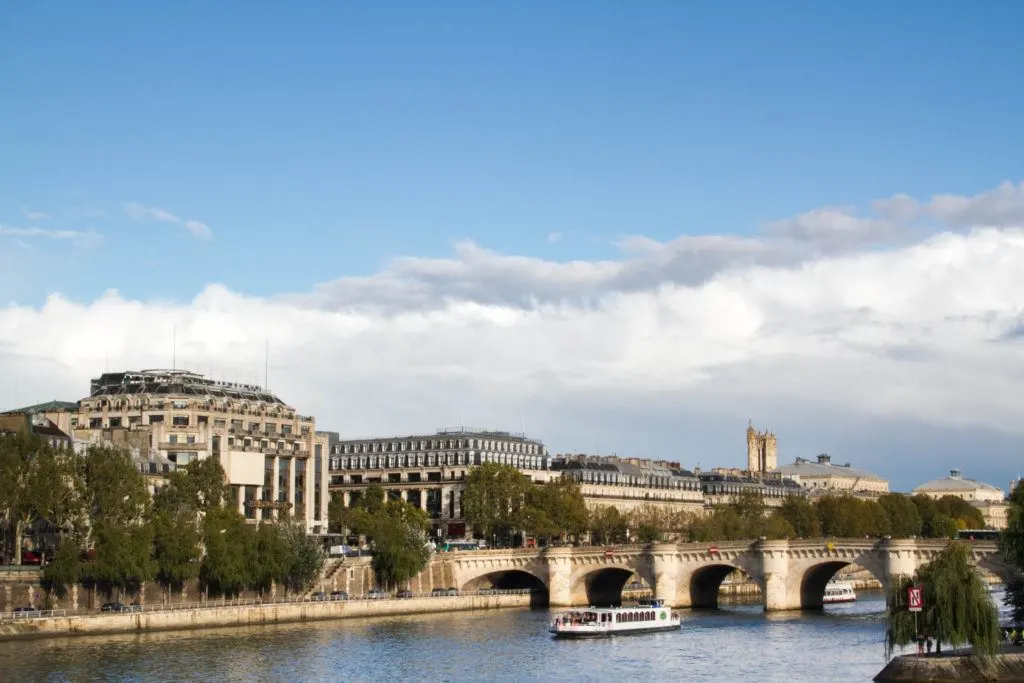
WHS #600 – Paris, Banks of the Seine
In junior high and high school, I took French, so going to Paris has always been important to me. Photos of the Seine, walks along the banks of the river, book stalls, cathedrals, and, in general, life just happens along the side of a river. The UNESCO site says that the city of Paris grew from the banks of the Seine, and this is very obvious to anyone who has crossed its many bridges.
All the iconic sites of Paris seem to be included in this inscription, like these:
- Eiffel Tower
- Notre Dame
- Sainte Chapelle
- Place de la Concorde
- Petit and Grand Palais
- La Louvre
- Palais de l’Institut
- Hôtel des Invalides
- Champs Elysées
Many of these sites will be on everyone’s visit list, especially if it’s your first time in Paris. However, I must say, I have been to Paris umpteen times and still keep going back to some of my favorites, like the Louvre and the shops along the Champs Elysées.
The banks of the Seine are beautiful both day and night, and needless to say, there are some great restaurants and places to sit and just enjoy the views along the way. One of our favorite places to eat is called “Le Frigate,” a small eatery across from the Louvre. At lunchtime it’s full to the brim, but the menu of the day is well worth a wait.
For a unique experience, grab a seat on a bank where you can see the Eiffel Tower just before the darkness sets in. Take with you a bottle of local Rosé and maybe some charcuterie items to snack on while you watch the evening light show. Don’t worry if you get there a little later, the light show is repeated on the hour.
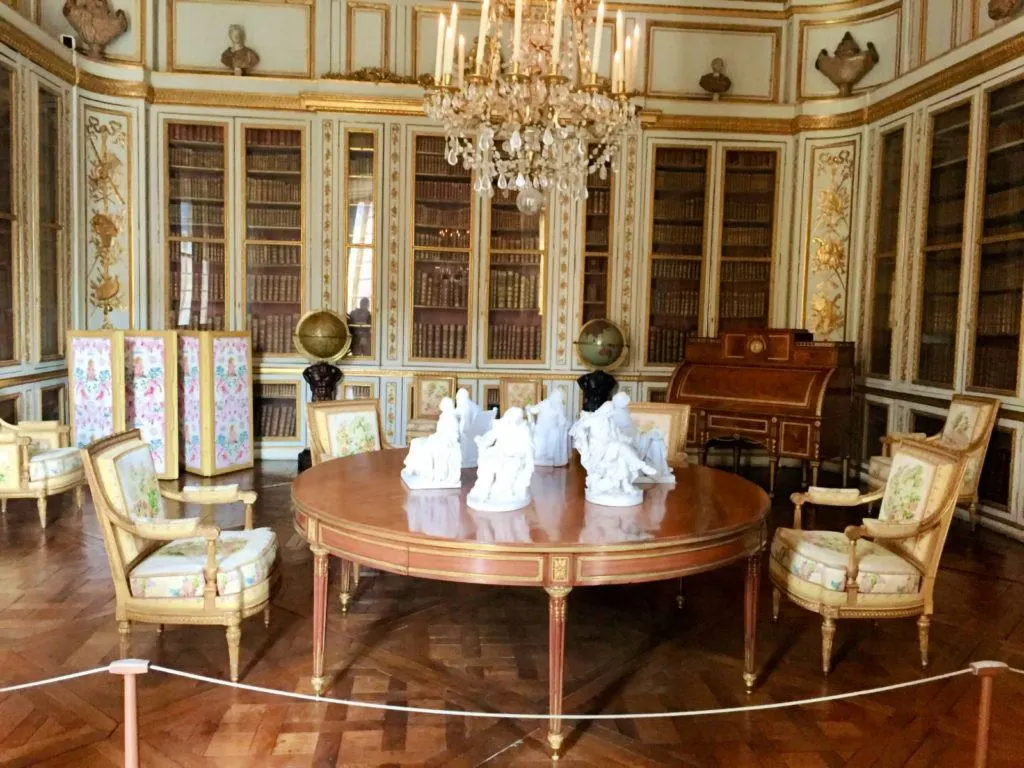
WHS #83 – Palace and Park of Versailles
By Karee of Our Woven Journey
The Palace of Versailles is located about 10 miles outside of Paris and is one of the most visited historical sites in the world. It is also one of the largest palaces and at one time housed all of France’s royal court.
Visiting Versailles brought about a range of emotions for me. For anyone even the least bit interested in history, it’s a rare glimpse into what life was like for the French nobility. It’s also fascinating to see many of the artifacts actually used by Kings and Queens over two hundred years ago. The over-the-top lavishness is quite exciting to see and includes stunning antiques and sculptures, ornate furnishings and a glimpse into their private lives.
The extreme wealth also made it easy to understand why the French commonwealth revolted and eventually overran Versailles in 1789. That was the last time any Monarchs lived there and it’s now a national museum. Versailles became a World Heritage site in 1979.
The palace grounds cover over 2000 acres and are as carefully designed as the palace itself. If you’re not up for walking, you can rent a bike or take a trolley to explore as much as you’d like. There are even a couple of places to get lunch or a coffee as you wander about.
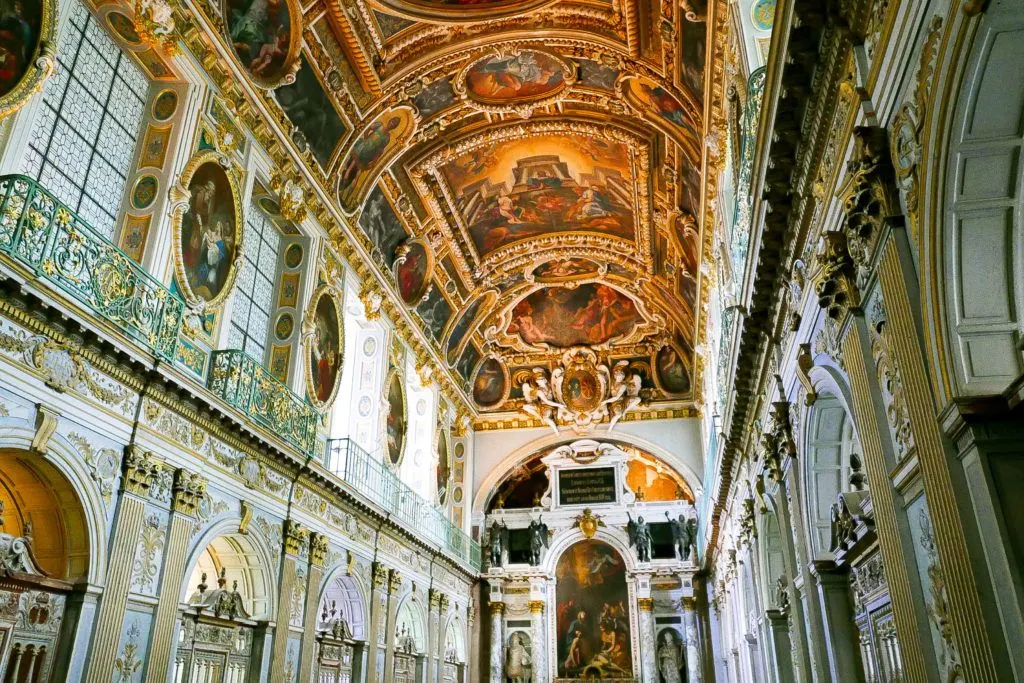
WHS #160 – Palace and Park of Fontainebleau
By Kenny of Knycx Journeying
Fontainebleau is a sought-after destination for a Paris getaway among the locals; it is also a perfect day trip for travelers because of its proximate location, historic value, and natural forest. The Château de Fontainebleau is a UNESCO World Heritage Site and a hidden gem in Paris’s backyard. Fontainebleau is merely 45-minutes away from Central Paris’ Gare du Lyon by train; If you are traveling with your family, consider going there in a rental car so that you can explore the heritage at your own pace.
Château de Fontainebleau is worth your visit because the palace is extravagantly decorated through centuries of expansion and remodeling, serving as the imperial residences of a number of French Kings from Louis VII to Napoleon III. It is also less crowded than Versailles, you can truly appreciate the many apartments, halls, and chapels without disturbance – each of them has its own signature and is distinctive by looking at the paintings, the furniture, and the wallpaper.
The palace was named one of the French King’s favorites residences as it is surrounded by a historic forest and a beautifully crafted Italian Renaissance garden. The garden is open to the public for free all year round. The English Garden (the Pine Garden) features beautiful landscaping, exotic trees, ornamental rocks, and winding pathways. To the end of the garden, the Grand Parterre is the largest French-style formal garden in Europe with 45,000 flowering plants, and a 1,200 meters long canal. To enhance your entire experience, this is also a place where you could hire a professional photographer for a photo-shoot, or hop on a hot air balloon to enjoy the view atop of the palace and the forest.
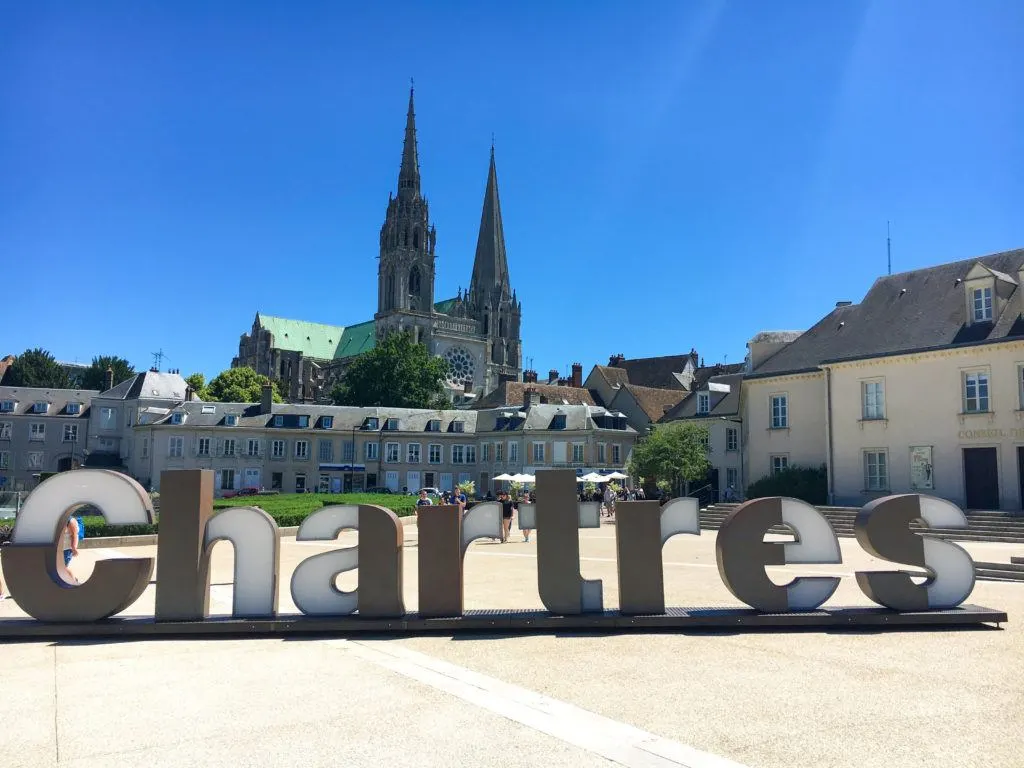
WHS #81 – Chartres Cathedral
By: Tegan + Alex of Why Not Walk Travel Guides
A stop at the magnificent Cathedral of our Lady of Chartres, a UNESCO World Heritage Site and popular pilgrimage site, is a must-see on any Loire Valley itinerary. Located just a short trip from Paris in the town of the same name, the cathedral is a masterpiece of French Gothic architecture, and is one of the best-preserved examples of Medieval architecture in Europe, with sparkling stained glass windows, 12th-century sculpture work, and its soaring nave and flying buttresses.
It was designated as a UNESCO World Heritage Site largely due to the fact that it is so astonishingly well-preserved, with the stained glass windows in particular dating back to the 1250s. Additionally, the architects of several other famous European cathedrals (such as those at Reims, Cologne, and Westminster) utilized Chartres as their inspiration.
Visitors of all ages will enjoy visiting both inside and outside, and should definitely budget some time to look at the stained glass windows in depth. You can also see a relic here: the Sancta Camisa, thought to be the shirt worn by the Virgin Mary at Christ’s birth. Entry to Chartres Cathedral is free, though those wishing to visit the crypts must pay 3 euros, and guided (paid) tours are available.
The town of Chartres has lovely places to stop for lunch, and is very quaint and walkable as well.
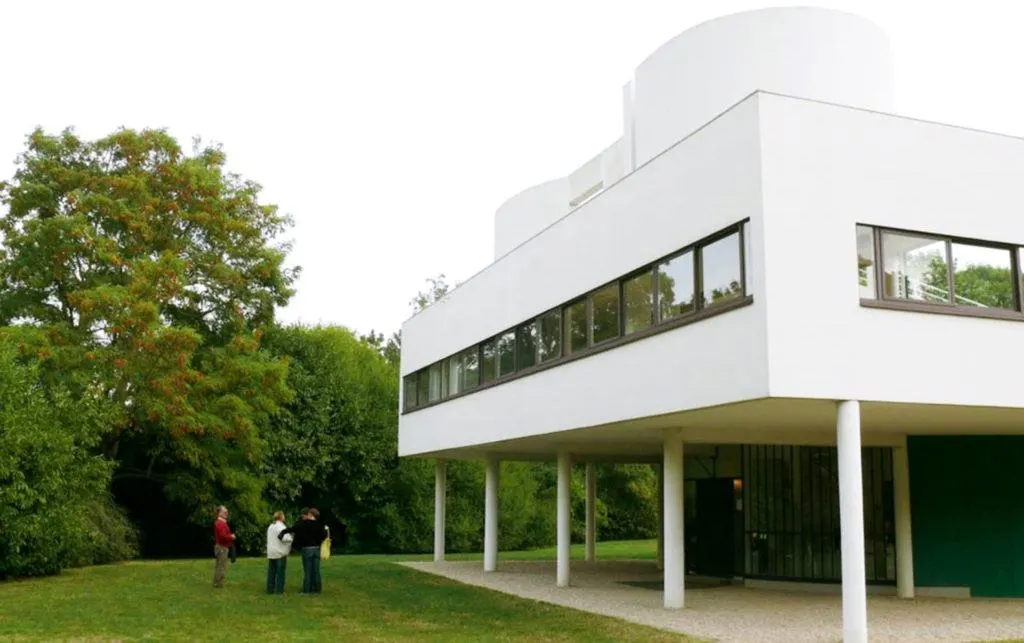
WHS #1321 – Villa Savoye, The Architectural Work of Le Corbusier, an Outstanding Contribution to the Modern Movement
By Elisa of World in Paris
The architectural work of Le Corbusier is part of the UNESCO World Heritage list. The international organization chose 17 of his most iconic works, which are located in 7 different countries.
Charles-Édouard Jeanneret (1887-1965), known as Le Corbusier, was a Swiss-French architect, now regarded as the father of Modern Architecture. He was contemporary of other renowned architects like Frank Lloyd Wright and Mies Van der Rohe.
The list of buildings listed UNESCO World Heritage located in France includes the Maisons La Roche et Jeanneret (Paris), Cité Frugès (Pessac), Villa Savoye (Poissy), Rental Building at Porte Molitor (Boulogne-Billancourt), Unité d’Habitation (Marseille), Manufacture at Saint-Dié-des-Vosges, Chapel Notre-Dame-du-Haut (Ronchamp), Le Corbusier’s Hut (Roquebrune-Cap-Martin), Convent Saint-Marie-de-la-Tourette (Eveux), and Maison de la Culture de Firminy.
If you can only visit one work by Le Corbusier, then head to Villa Savoye. Located in Poissy, it is one of the easiest day trips from Paris. Villa Savoye was designed as a country house for a couple of friends, who gave the architect total freedom for the design. In this house, you can see for the first time Le Corbusier’s principles of Modern Architecture: the use of pilotis (stilts), free open plan, free design of the façade, horizontal windows, and roof garden.
Le Corbusier’s architecture is not everybody’s cup of tea. I am an architect, so Villa Savoye, Ronchamp, and the other houses in Paris were special places to visit after so many years studying his work!
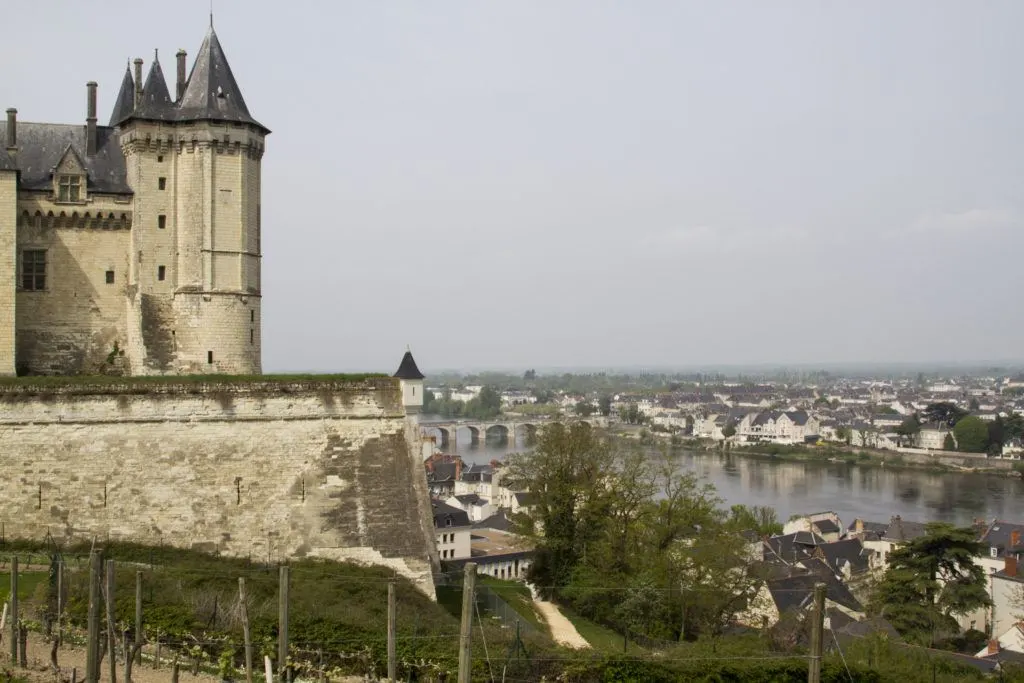
WHS #933 – The Loire Valley between Sully-sur-Loire and Chalonnes
We took a week long trip through the Loire Valley in April. What a glorious time to visit this beautiful river valley. The wisteria was blooming and it just made the whole trip that much prettier.
The 280 kilometers of the Loire Valley that are insrcibed are famous for the architecture of the castles as well as the irrigation that the river has provided over the centuries. It’s well worth a trip down the Loire to experience the castles and beauty of the valley.
Some of the castles that are included in the inscription are:
Castles
Amboise
Azay-le-Rideau
Blois
Chambord
Chenonceau
Cheverny
Sully-sur-Loire
d’Angers
Historic Towns
Blois
Chinon
Orléans
Saumur
Tours
Churches and Abbeys
St. Nicholas de Blois
Cunault Cathedral
Saint-Benoît-sur-Loire
Abbaye de Fontevraud
As you can see from the list, there is plenty to keep you busy in the Loire for much longer than a week. We were driving, and it was essential. So much of exploring the Loire is driving in between the various important sites.
The way we tackled the many things to do with not getting tourist burn-out is pick one or two sights to concentrate on in the morning. It really doesn’t matter what you pick to do, it’s all pretty amazing. We loved the castles, and typically you have to take a tour to visit them so that takes up some of your day. However, the towns and churches take much less time.
After our fill of being tourists for the day, we would find a great place to sit and have a leisurely French lunch with some great “formule” options (menu of the day). We would kindly ask our waiter which was his favorite local wine that he would recommend, and we’d order a bottle.
French waiters know their wines, and they were never wrong. After our lunch, we would go find that particular winery, do some tasting, and stock up on a case or two of their best. You see, Loire wines are top-notch, and this was a way to celebrate all parts of the Loire Valley.
WHS #873 – Provins, Town of Medieval Fairs
By Mark from Wyld Family Travel
History tells us that Provins was an important medieval market town as far back as the year 800. Provins today is as it was like 1200 years ago thanks to its defensive walls and ramparts. In 2001, UNESCO recognised the authenticity of Provins and granted it UNESCO World Heritage status. A visit to Provins is a popular day trip from Paris and home to an annual week-long medieval festival held during the summer months.
We attended the festival with 2 young children in hand and enjoyed the festivities, from medieval music to dancing, from cooking to craft-making it was quite an experience for the whole family. The town does become very packed and overrun with visitors during the festival and we recommend arriving as early as possible.
During other times of the year, you can visit and enjoy the sights of Provins more easily. We suggest you walk the city walls, visit Ceasars Tower, The Tithe Barn and the Saint-Quiriace Collegiate Church. All of these building have a history dating back to at least the 12th century. The rose garden of Provins is made famous by the Damascus rose. Thibaud, the Count of Champagne returned to Provins from Crusading in the Holy Land with the famous Damascus rose.
Stage shows are enacted daily in the high season featuring falconry and horse riding and medieval duals. These shows are very popular and we suggest booking online prior to arriving. Provins make a great day trip from Paris.
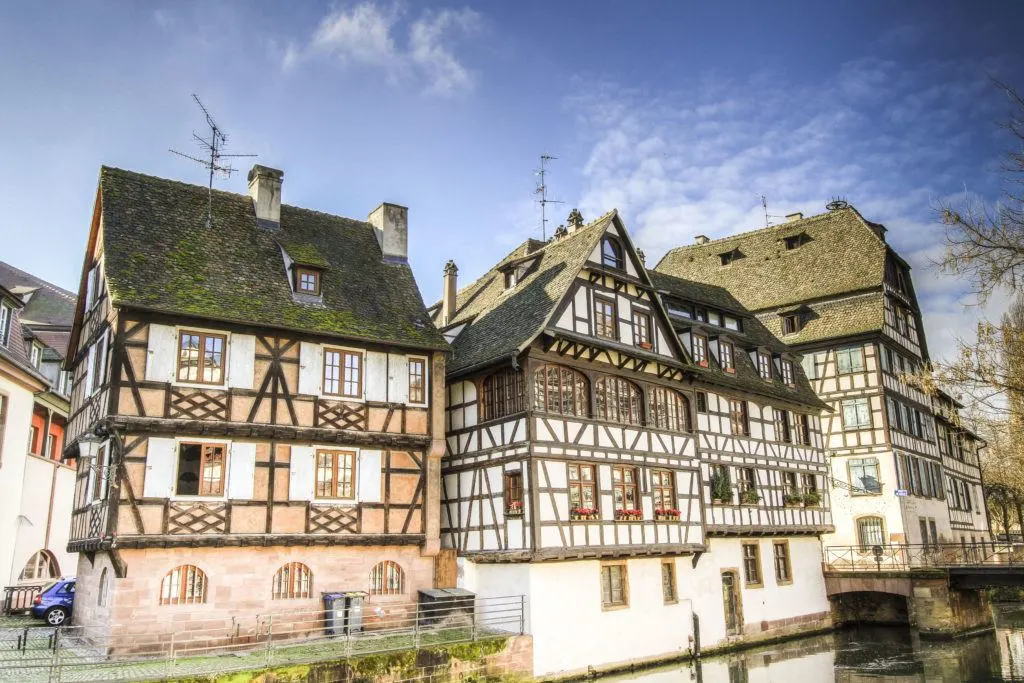
WHS #495 – Strasbourg, Grande-Île and Neustadt
Strasbourg is one of my favorite cities in France. Located in Est France, it historically has flipped back and forth between French and German ownership at least four times. The UNESCO inscription celebrates this with its two parts.
Firstly, the old town, the Grande-Île is a little over one kilometer long. It’s number one sight is the Notre Dame Cathedral, a gothic beauty. The best part of the area is the half-timbered houses, quaint shops, and Pont Couverts-a bridge connecting it to the Petite France part of the city.
The second part of the inscription is in the Neustadt, New City. In the 1870s, after the Franco-Prussian War, Strasbourg became part of Germany again. At that time, construction took off and the buildings in the newest part of the city were modernized. New technology allowed a new sewage system, the streets to be paved, and a new railway (source).
All in all the contrasts of architecture, the melding of the French and German influences, and the sheer beauty of the city makes Strasbourg and its surroundings on the Route de Vins a fantastic destination to spend a minimum of a few days.
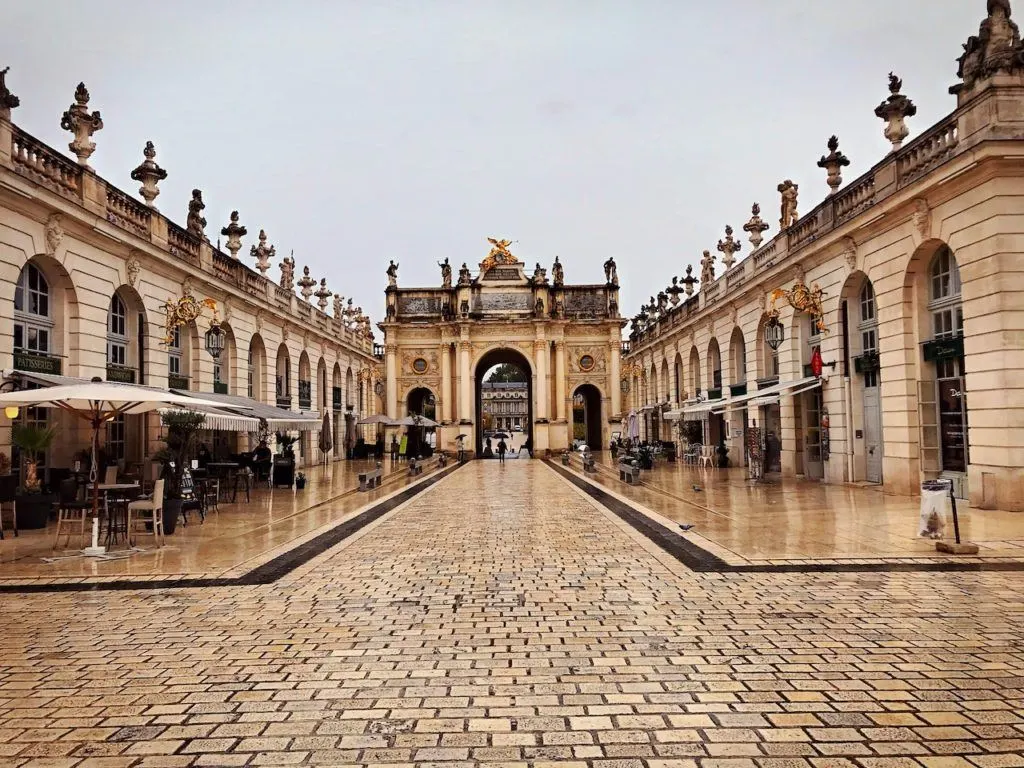
WHS #22- Place Stanislas, Place de la Carrière and Place d’Alliance in Nancy
By Ania of the Travelling Twins
The city of Nancy has a lot to offer. It is the capital of Lorraine and one of France’s oldest cities. But for me, a visit to Nancy was important for a different reason.
Worldschooling my kids, I wanted to introduce them to a famous Polish person – Stanislaw Leszczyński – who was a Polish King who was not very popular or appreciated. So in 1709, he had to flee the country and become known as a king without the kingdom.
In Poland, the opinion of Stanislaw Leszczynski was that he wasn’t a very good king. Still, paradoxically as a Duke of Lorraine was perceived as an enlightened monarch who proved to be sensitive to the needs of the public. His most significant achievement was building the Royal Place – as a tribute to King Louis XV, and known now as The Place Stanislas.
The Place Stanislas is massive, measuring 125 metres in length and 106 meters in width. It is paved with light-coloured stones, and two lines of stones form a diagonal cross motif. The square is surrounded by majestic buildings like City Hall, Opera House.
The fourth side has a lower building and Arch de Triumph leading to Place de la Carrière. Other entrances (beside the Arch) to the square are from corners through heavy massive iron/gold gates with fountains in the middle of them.
Everything on Place Stanislaw is grand, so not surprising that it became a UNESCO site in 1983.
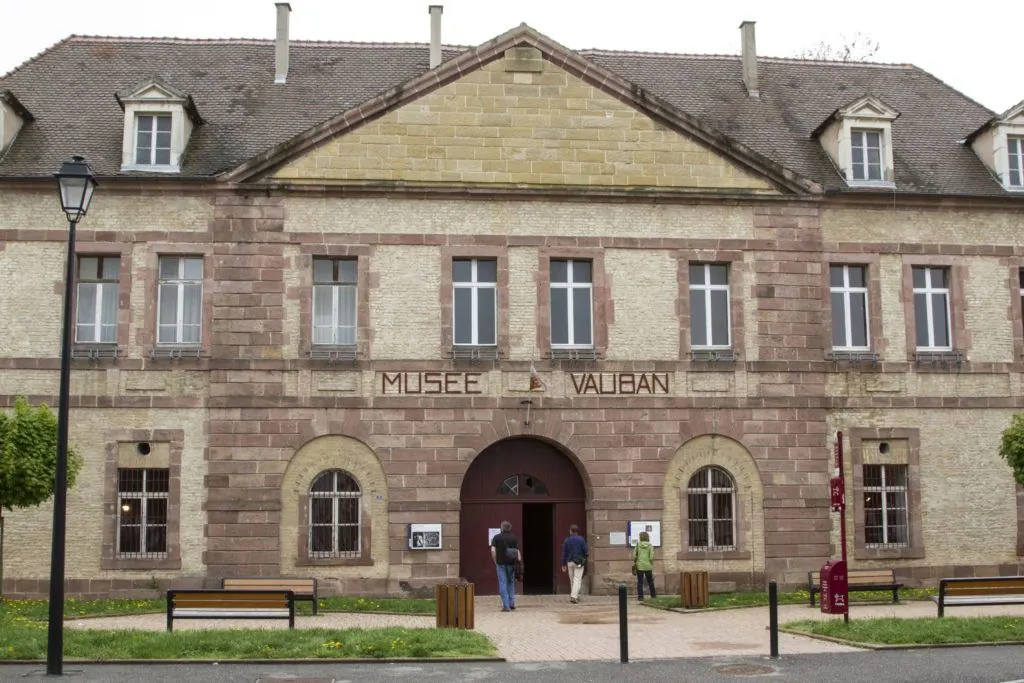
WHS #1283 – Fortifications of Vauban
Sébastien le Prestre de Vauban (1633 – 1707) was a renowned military strategist and architect. The fortifications he engineered have many distinct characteristics that have been copied by countries all over the globe. His innovative star fort designs with multiple corners and angles to defend the fort became the new model.
One of the largest fortifications was the citadel of Lille, but there are many more places that Vauban had a hand in engineering. In fact there are 12 properties inscribed on the world heritage list:
- Citadel of Arras
- Citadel and the Fort Paté et Médoc de Blaye / Cussac-Fort-Médoc
- The Golden Tower of Camaret-sur-Mer
- The stronghold of de Mont-Dauphin
- The stronghold of Neuf-Brisach
- The Tatihou and Hougue towers-observatories
- Citadel and Griffon Fort, Besançon
- The forts of Salettes and des Trois-Tête
- The stronghold of Longwy
- The enclosure and the citadel of Mont-Louis
- The citadel and enclosure of Saint-Martin-de-Ré
- The city wall, the fort and the Cova Bastera of Villefranche-de-Conflent
Whether you are interested in military history or not, the Vauban fortresses and citadels are amazing works of a 17th century engineer that have endured for centuries. They are a lot of fun to wander around, and kids of all ages will enjoy them.
One last fact to keep you hooked, is that Napoleon held Vauban in such high regard that he ordered his heart be transported to Paris and laid to rest in Les Invalides.
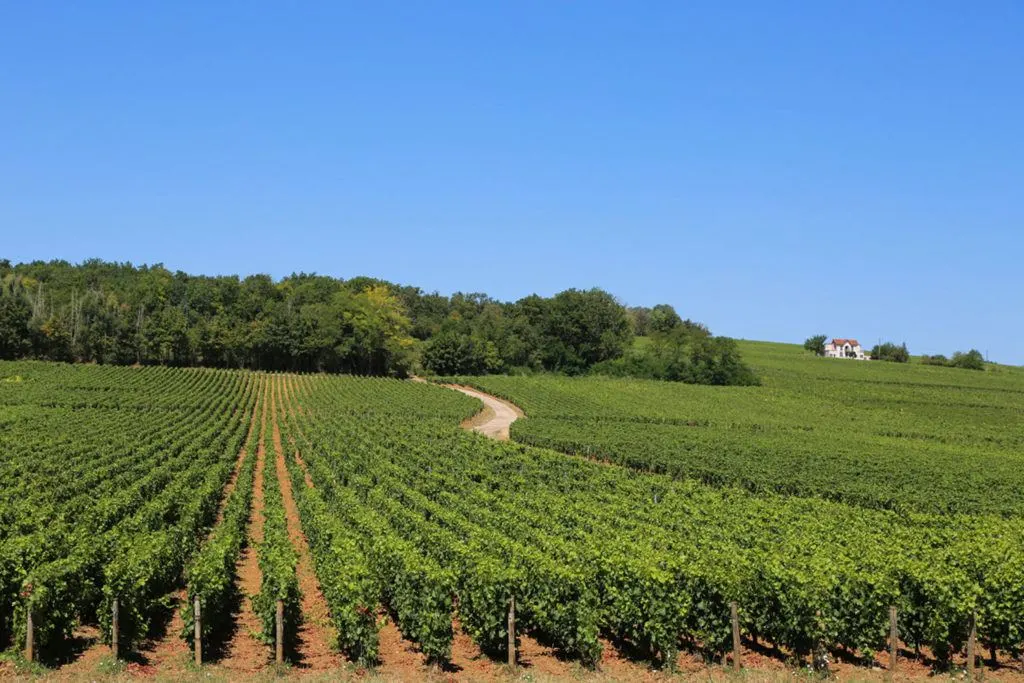
WHS #1425 – The Climats, Terroirs of Burgundy
By Elisa of Travel France Bucket List
The ‘Climats,’ terroirs of Burgundy, are one of the French sites listed as UNESCO World Heritage. This area in Burgundy, between Dijon, Beaune, and Santenay, is world famous for its unique character of wine growing and producing, which dates back to medieval times. The region of Burgundy has some excellent red wines made from pinot noir and white wines obtained from chardonnay.
The Climats of Burgundy designation comprises the Burgundy vineyards but also an exceptional built heritage of chateaus, medieval abbeys, and more.
The best way to explore this area is by following one of the Burgundy wine routes: Route des Grands Crus de Bourgogne, Route des Grands Vins de Bourgogne, Route du Mâconnais-Beaujolais and more. From Beaune to Dijon, the Route des Grands Crus is the most famous because it explores the vineyards producing the most prestigious wines.
We explored the Route des Grands Crus recently, and we loved the combination of wine history and heritage. The drive from Beaune to Dijon takes no more than 3 hours, but we took four days to complete the route. The cities of Beaune and Dijon deserve an entire day each plus we wanted to enjoy the landscapes, visit small towns and tourist attractions and do some tastes.
In addition, this area is dotted with stunning chateau-hotels, which call for a lazy day by the pool enjoying your favorite wines.
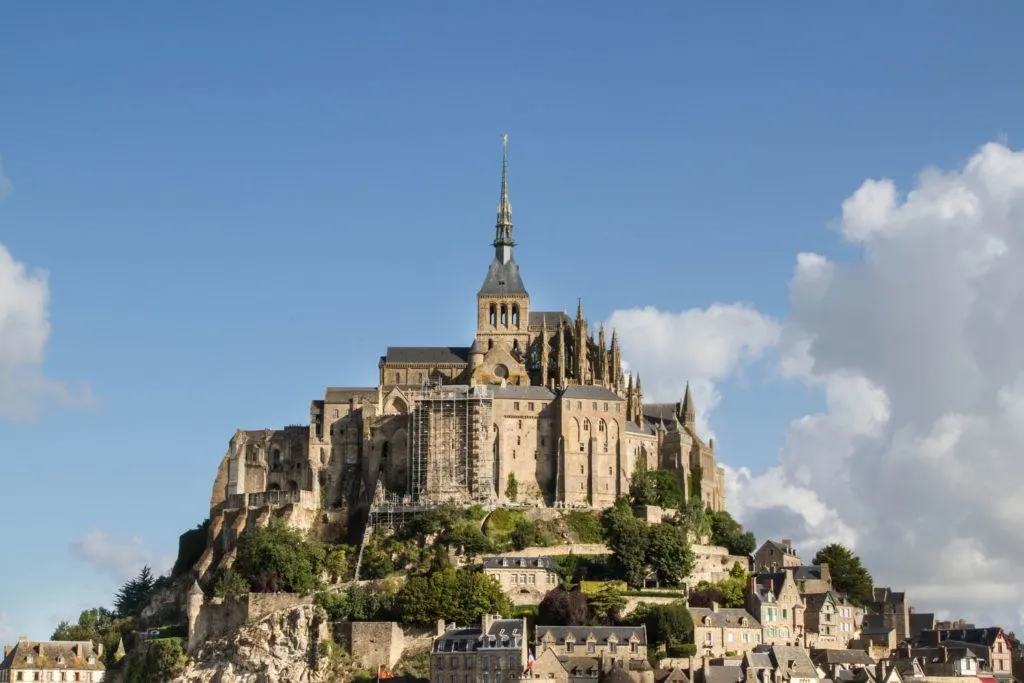
WHS #80 – Mont-Saint-Michel and its Bay
As I mentioned, I took French in high school, and I remember my French class reading a student’s copy of Les Miserables by Victor Hugo. He wrote this novel after his visit to Mont St. Michel, and I’ve always associated the two together.
Hugo’s feelings about Mont St. Michel can be summed up in this quote. “Yesterday I was at Mont-Saint-Michel. Here, one should pile up superlatives of admiration, as man has piled buildings onto the rocks and as nature has piled rocks onto the buildings.” I couldn’t agree with him more.
When I finally got a chance to visit this amazing sight on a road trip we took in Brittany and Normandy, I was thrilled. Mont St. Michel is famous for its Benedictine Abbey perched at the top of the island. The UNESCO inscription includes the difficulty in building such a structure in such harsh environs.
However, it is one of the most touristed sites in France, with over 2.5 million visitors a year. That means that during the high season, and most of the year, the narrow streets are crowded with people from all over the world.
There are not many locals who live there, which makes the hotels, restaurants, and parking expensive and hard to find. When we were climbing the streets to the abbey, it was so crowded that it was difficult to walk.
No matter what, though, Mont St. Michel is an imposing piece of historic architecture that can be seen for miles around. For me, the best part of our visit was when we left. The sun was setting, the tide was out, and we enjoyed the silhouette.
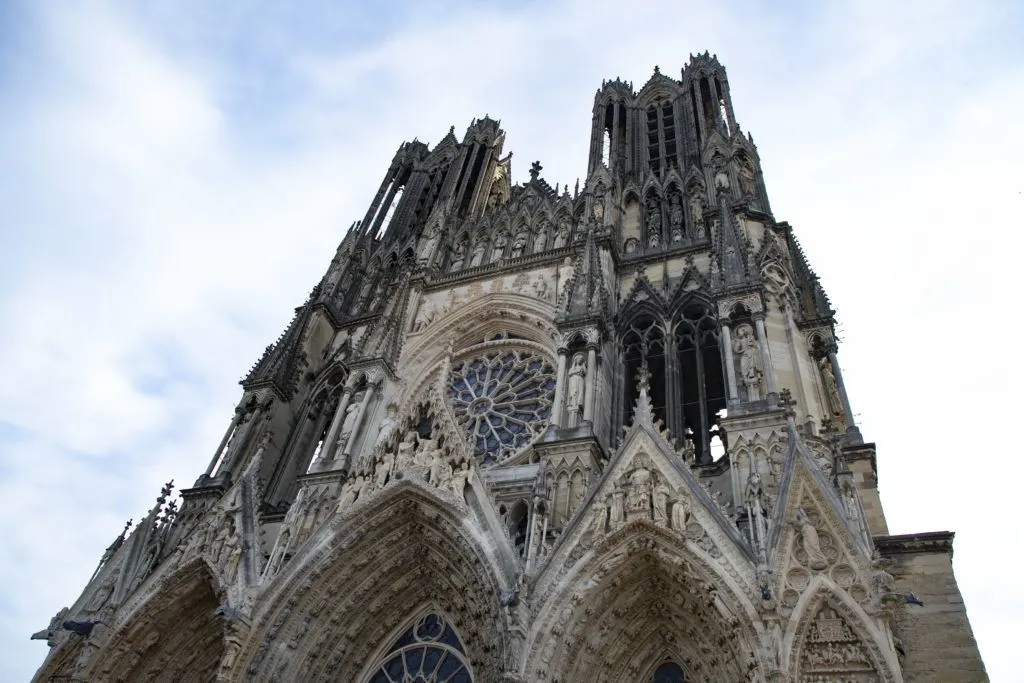
WHS #601 – Cathedral of Notre-Dame, Palace of Tau, Reims
The towering cathedral of Reims, another named Notre Dame, is one of the most important Christian sites in France. The ornate gothic architecture aside, this cathedral is known for the coronation of 33 French Kings.
There are many highlights when visiting the cathedral and the Tau Palace which is connected to it. For the cathedral, the many statues that adorn the exterior and the interior of the building, are works of art and history.
Even though the cathedral was destroyed during German bombing in World War I, it has been restored almost to its former glory. Taking a tour through this amazing site will be one of the highlights of your trip to France.
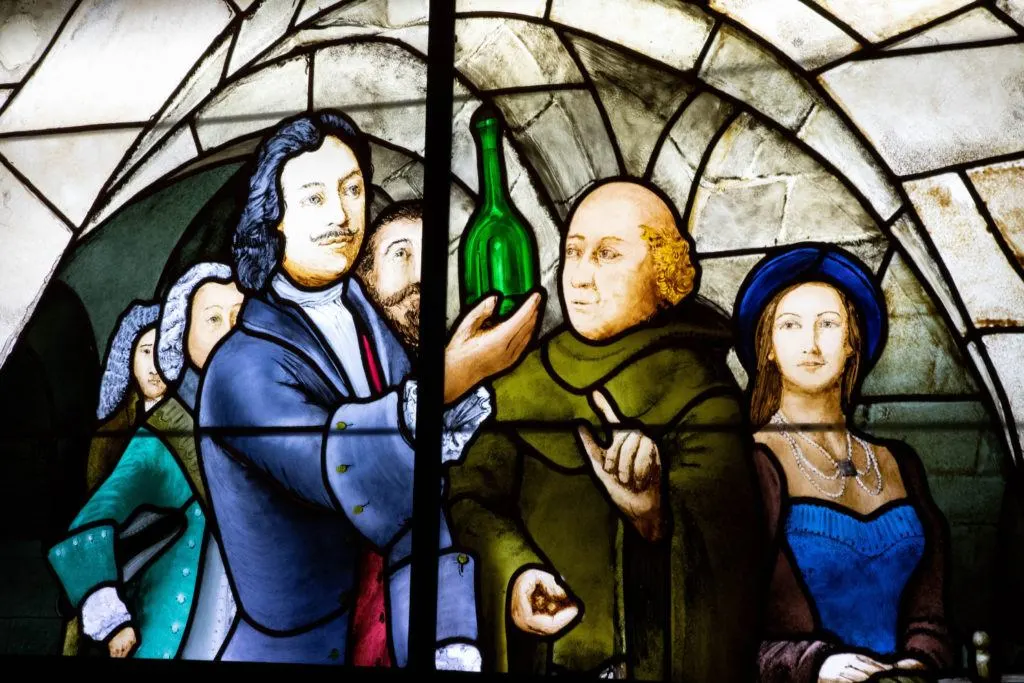
WHS #1465 – Champagne Hillsides, Houses and Cellars
Along with the Reims Cathedral, the fields of grapes in this region are designated for the king of wines, champagne. As with many French products, sparkling wines across the world cannot use the word “champagne,” because that is only for this part of France. The UNESCO inscription is dedicated to the entire process from vineyard to bottling of the champagne.
There are a few main areas that are included where you can witness the process and taste the wines. They are Hautvillers, Saint-Nicaise, and Épernay. The best way to experience the area is to take a tour where someone will do all the driving for you between champagne houses. We took an all day champagne tour with lunch included, and at the end of the day, we’d tried well over ten champagnes. It was a lot of fun to do with our friends.
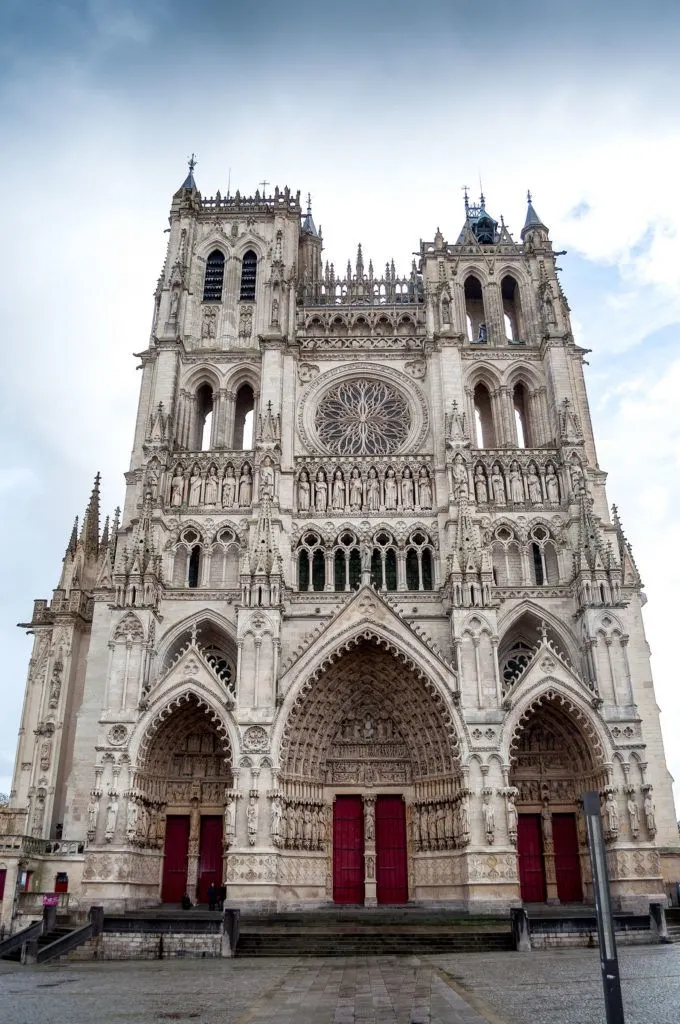
WHS #162 – Amiens Cathedral
By Suzanne Jones from The Travelbunny
Amiens Cathedral, which celebrated its 800th birthday in 2020, is an imposing structure of gothic grandeur and one of the finest I’ve visited. To put it in perspective, the Basilique Cathédrale Notre-Dame d’Amiens is the biggest cathedral in France, both in terms of height and size. Notre-Dame could fit inside twice with more than a little wiggle room.
The western façade of the 13th century Cathedral is graced with intricate carved portals, striking stonework and a sweep of statues immortalizing kings and apostles. Scenes showing everyday life are also represented, some quite tongue in cheek if you look closely.
Step inside Amiens Cathedral and you’ll discover a light filled structure with towering columns which give it an aura of elegance. The intricate stained-glass windows are stunning especially the 16th century rose window.
I recommend a visit in the summer or in December when Chroma ‘the Cathedral in Colour’ takes place. The highlight of our visit was our return in the evening for this stunning light and sound display projected onto the façade of the Cathedral which lasts around 30 minutes.
During renovations it was discovered that the statues on the facade of the Cathedral were originally brightly painted. The light show, son et Lumiere, was devised to show how the cathedral would have looked. It’s absolutely spectacular.
Amiens is easy to visit for a day from Paris and is under two hours from Calais by car and a must stop during your visit to northern France.
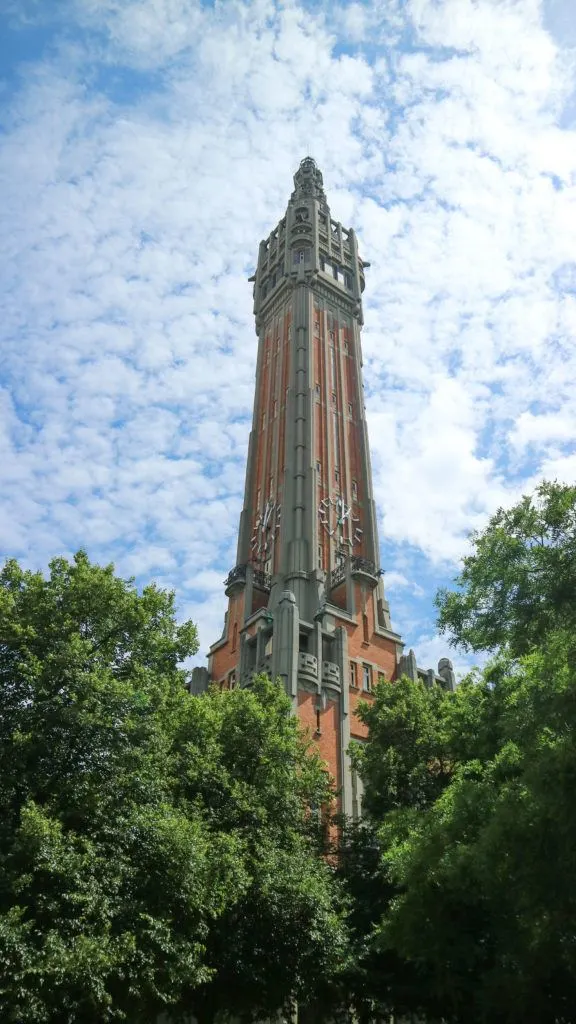
WHS #943 – Belfry of Lille – Belfries of Belgium and France
By Lara of The Best Travel Gifts
There are a total of 23 belfries spread over northern France which, together with 33 belfries located in Belgium, were added to UNESCO’s world heritage list in 1999. The belfries are often part of the city halls and serve as an architectural representation of the population’s growing independence from religious institutions.
Besides the fact that the belfries are a symbol of history, they are also aesthetic, large towers, making them great photo locations. On top of that, if the belfry is open for visitors, they also offer great views over the cities in which they are located. Making them excellent places to visit for parents and kids.
It’s the combination of history, architecture, great views, and generally cheap access that make the belfries worth a visit if you find yourself in a town that is home to a world heritage listed Belfry. Though, I wouldn’t recommend visiting all 23 towns just to visit the belfries. After having visited one or two belfries, you get the picture. Which will probably look a lot like the one in the photo (this is the Belfry of the City Hall in Lille).
Also, keep in mind that most belfries date back to a time when accessibility was not considered during its construction. So you probably need to climb some steps to get access to the top.
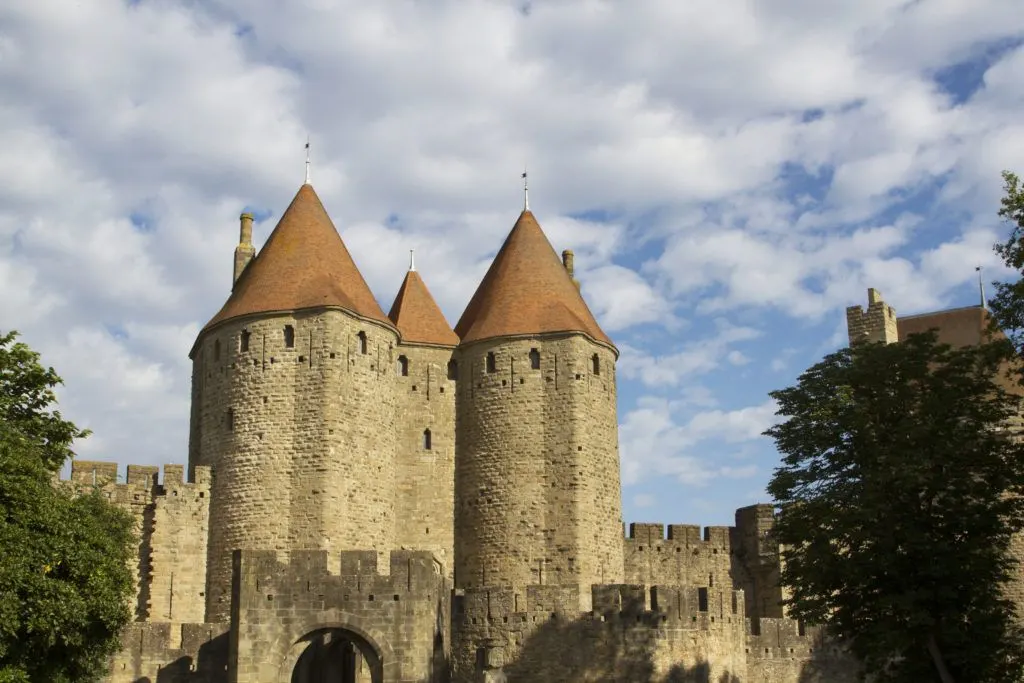
WHS #345 – Historic Fortified City of Carcassonne
After living and traveling in Europe for several years, you’d think medieval architecture would get a little old. You know, you’ve seen one castle you’ve seen them all right? Well, that just isn’t true at Carcassonne. When first seen in the distance it rises up out of the surrounding flowering fields as an imposing, fairytale collection of massive stone walls and cone-topped towers. It is truly a sight to behold!
The historic fortified city of Carcassone, by far one of the most beautiful cities in France, located in the south is a short drive from Toulouse. UNESCO added it to the World Heritage list in 1997 based on two criteria. First off, Carcassonne is a stunning example of a medieval fortified town. The collection of crenelated city walls, towers, imposing gates, and strategic defensive zones are unlike any others.
The second criteria cited for Carcassone’s inscription is based on the restoration work carried out on the city’s fortifications in the mid 1800s. At that time the city’s ramparts, walls and towers were in sad shape. Eugène Viollet-le-Duc, Napoleon’s chief ambassador, was given the task of restoring everything to their former glory. His approach to modern reconstructive architecture became a model for others to follow. The end result at Carcassone is the premiere example of medieval military architecture in Europe. Oh yeah, it also became a major tourist attraction.
To avoid the crowds of visitors, try arriving early in the morning. Better yet, plan an overnight stay in the fortified city to enjoy the cobbled alleys, stone ramparts, and picturesque courtyards in a much quieter state. Why not stay right in the medieval citadel at the amazing Hôtel de la Cité Carcassonne right in the middle of everything.
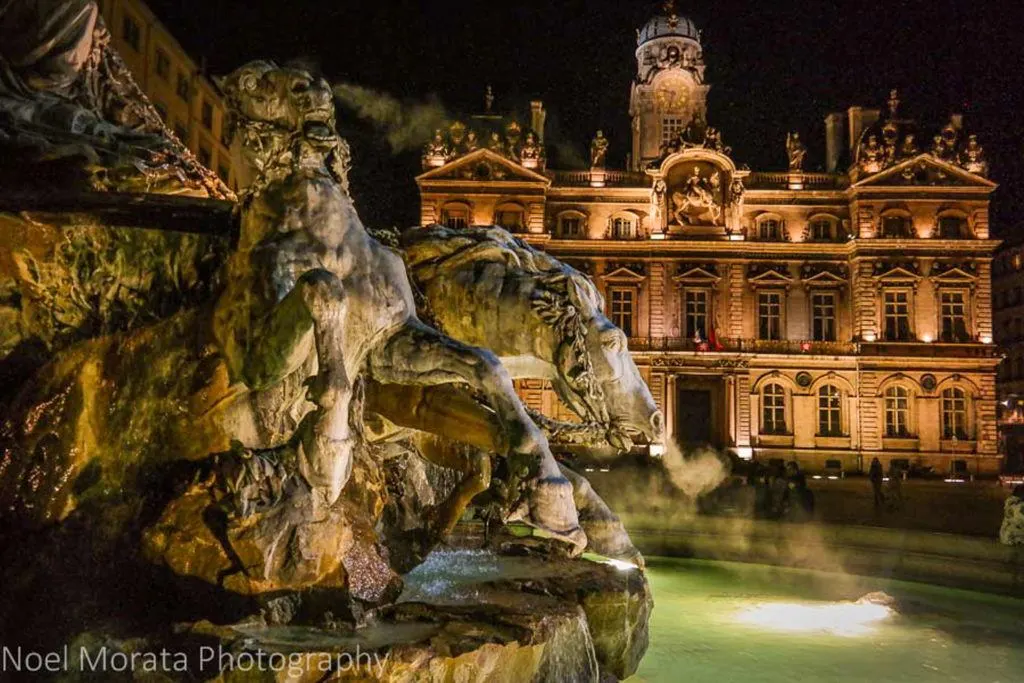
WHS #872 – Historic Site of Lyon
By Noel of Travel Photo Discovery
The World Heritage city in the city of Lyon is in the medieval historic center of the city which is located across the Saone river into the Vieux Lyon or Old Lyon town. The medieval quarter is touristy but not as much as other areas of France like Paris and in the later part of the day, the area is populated with locals hanging out in the main squares and restaurants that spill out into the streets and plazas of the center.
Vieux Lyon is fun to explore and climb up to the top with spectacular views of the city. From above you can visit the ornate Basilica of Notre-Dame de Fourviere with its imposing facade, twin towers and elaborate interiors. Afterwards, walk downhill and visit the historic Roman ruins and theater that is also fun to explore. The best time to be in the area is late afternoon to enjoy a walk, sunset at the top with gorgeous views and then finding one of the many fabulous local eateries that serve the most amazing regional cuisine specialties of the area. For more inspiration, check out my post in visiting historic Lyon here for the medieval town and other impressive parts of the city to enjoy and explore.
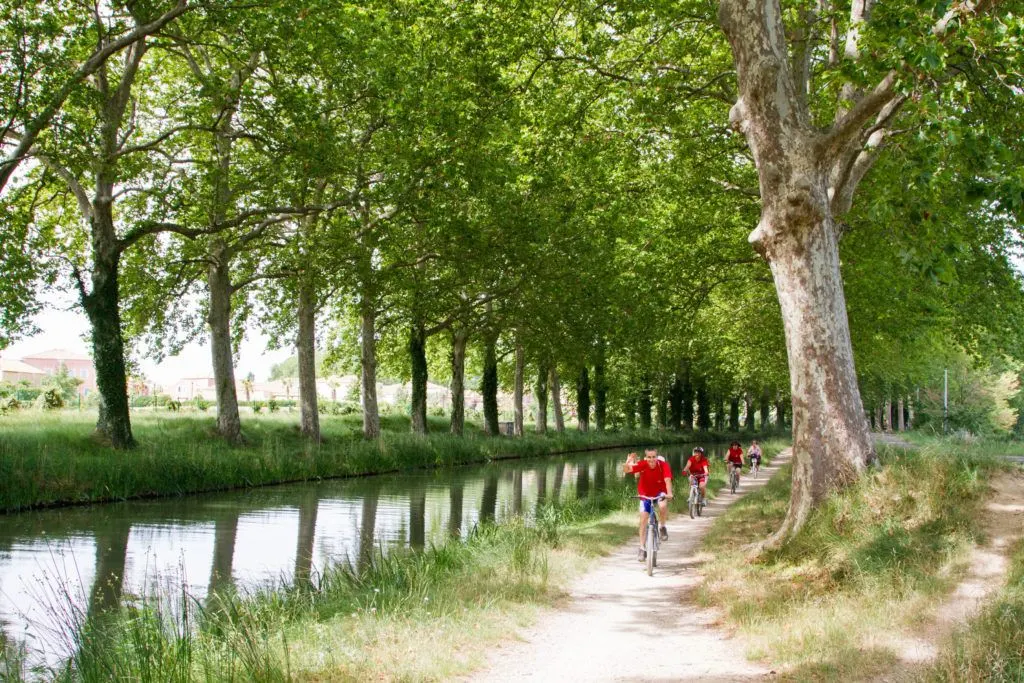
WHS #770 – Canal du Midi
I’ll be honest, I had never heard of the Canal du Midi even after traveling quite a bit in France. Then one day we were driving in the countryside between Carcassone and Narbonne, two world heritage sites, during the lunch hour. Google maps led us to a small little canal side restaurant where we had a superb lunch with some equally excellent wine. The whole time we were sitting and watching boats slowly make their way through a nearby lock.
Curiosity got the better of me and I just had to know about this canal. “It is the famous Canal du Midi, connecting the Atlantic to the Mediterranean, one of the greatest French engineering projects of all times!” Boasted our waiter in response to my, what must have seemed to him imbecilic, question. Sure enough, as we were driving out of the parking lot we saw an informational sign giving all the facts and history of the Canal du Midi.
The section of canals known as the Canal du Midi runs between Les Onglous, through Agde on the Med coast, inland through Carcassonne, and on to Toulouse. It’s comprised of over 300 kilometers of navigable water ways flowing through an intricate system of locks, aqueducts, bridges, and tunnels. Boat rentals are available at key points along the canal. What a grand tour that would be! This is definitely something I’ve added to my bucket list.
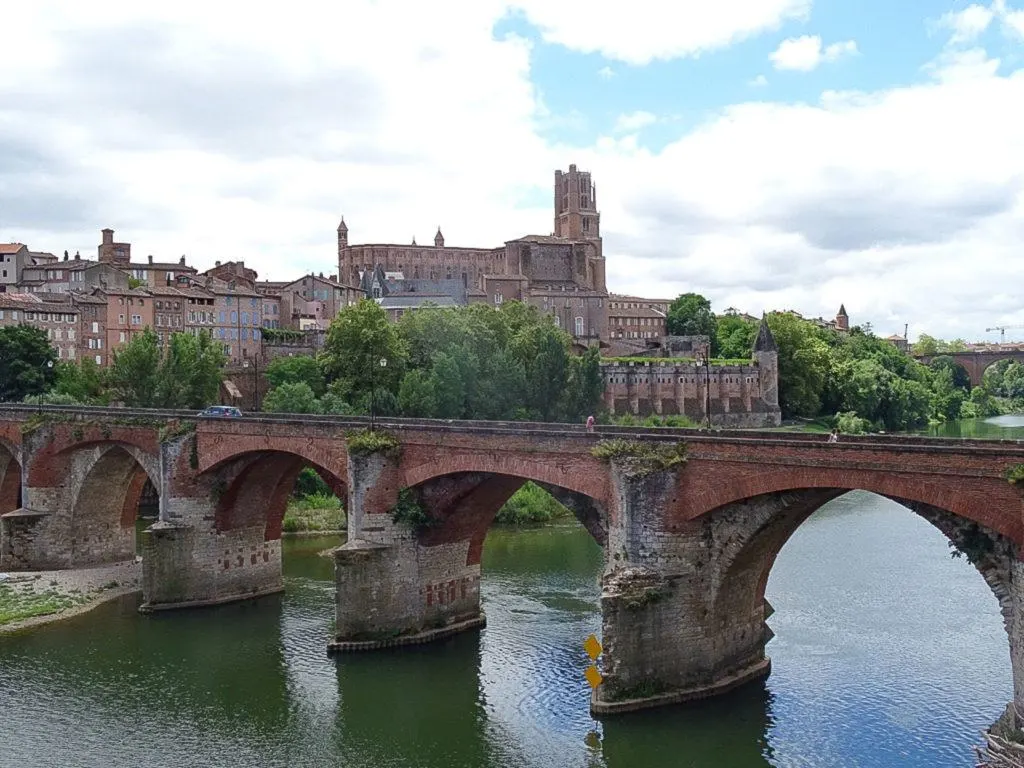
WHS #1337 – Episcopal City of Albi
Contributed by Carolyn of Holidays to Europe
With three significant historical structures at its heart, it is no wonder that UNESCO declared the Episcopal City of Albi a World Heritage Site in 2010. Albi became a powerful episcopal city in the 13th century, following the Albigensian crusade, and the buildings that still stand today are a reminder from the Catholic Church’s hierarchy of the power they held.
The centerpiece of Albi is Cathedral-Ste-Cecile, an enormous building that some say is the largest brick building in the world. A visit to the cathedral is one of the most popular things to do in Albi. Built in the pink-hued stone that is synonymous with the area, the Cathedral has a rather austere exterior with a bell tower that can be seen across the city.
The cathedral’s interior is a different story. The hand-sculpted wooden carvings, stained glass windows and colorful frescoes are some of its many features that will take your breath away.
Across the square from the cathedral, Berbie Palace once served as the Bishop’s Palace but is now home to the Toulouse-Lautrec Museum. It is regarded as one of the best preserved episcopal palaces in France. If you’re interested in art, the museum displays a large collection of the Albi-born painter’s work.
Adjoining Berbie Palace is a magnificent garden, based on the gardens at Versailles. The gardens also provide a perfect view point of the River Tarn and another significant historical structure, Pont Vieux.
The Old Bridge, which dates back to 1040, sits on eight arched supports, spanning the Tarn. Where horses and carts once crossed, today the bridge is a busy crossing point for cars entering the historic town centre.
There are numerous viewing points that are signposted on the other side of the bridge that offer wonderful views of the cathedral and Berbie Palace. We were lucky to be directed to another view point at the far end of Rue du Tendat from where we looked directly across the river to the Berbie Palace.
Albi is an attractive city with a fascinating history and a compact Old Town. If you are in the south of France, it’s well worth visiting this UNESCO World Heritage site.
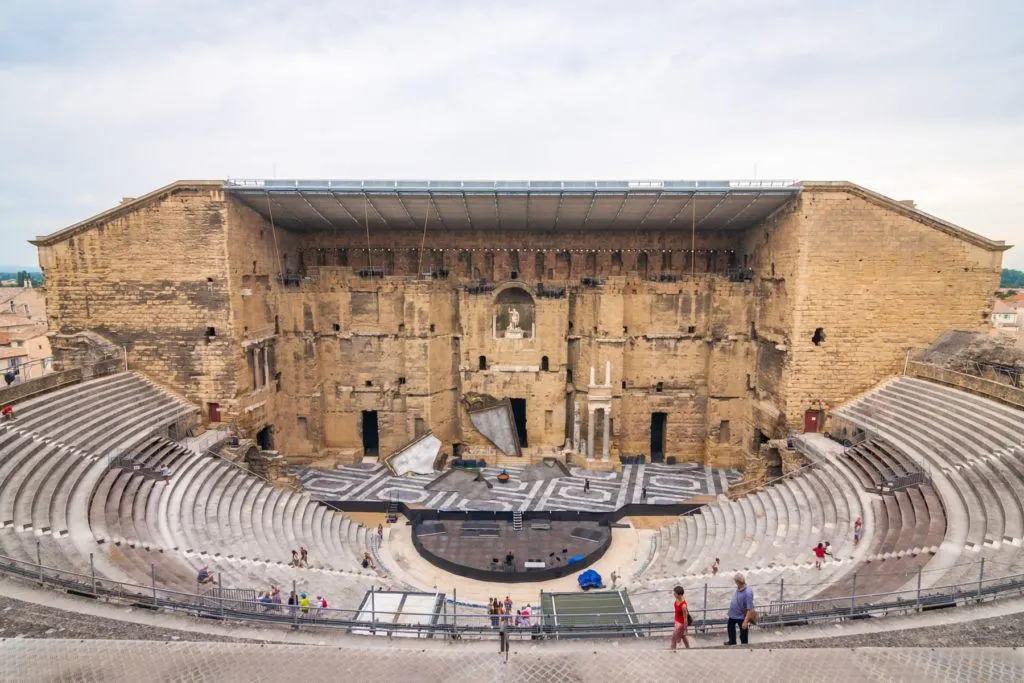
WHS #163 – Roman Theatre and its Surroundings and the “Triumphal Arch” of Orange
By Manouk of Groetjes uit Verweggistan
In the city of Orange you will find the Roman Theater of Orange. It was built in the first century AD and is one of the best preserved Roman theatres in the world. When you visit the theatre nowadays you can still imagine how spectacular it must have been with the grand stage. Better even: you can still watch performances here!
Besides the theater (which is definitely worth a visit) you can also visit the interesting Arc de Triomphe or the beautiful cathedral in Orange. But my favorite part of Orange is definitely the theatre. It is very impressive and looks spectacular. During my visit the stage was dressed for a big opera, which made it even more real. I highly recommend taking the audiotour and learning more. If not, you might be done soon, but it will be hard to ever again see such a wellpreserved theatre anywhere else in Europe.
Many also visit because of the connection of Orange with the Dutch history. The Dutch royals descend from the Principality of Orange. William the Silent inherited the title Prince of Orange in 1544 and the current royal family is still from the House of Orange-Nassau. This also explains why orange became the national color of the Netherlands! Especially as a Dutch citizen it is interesting to see the place where this name came from.
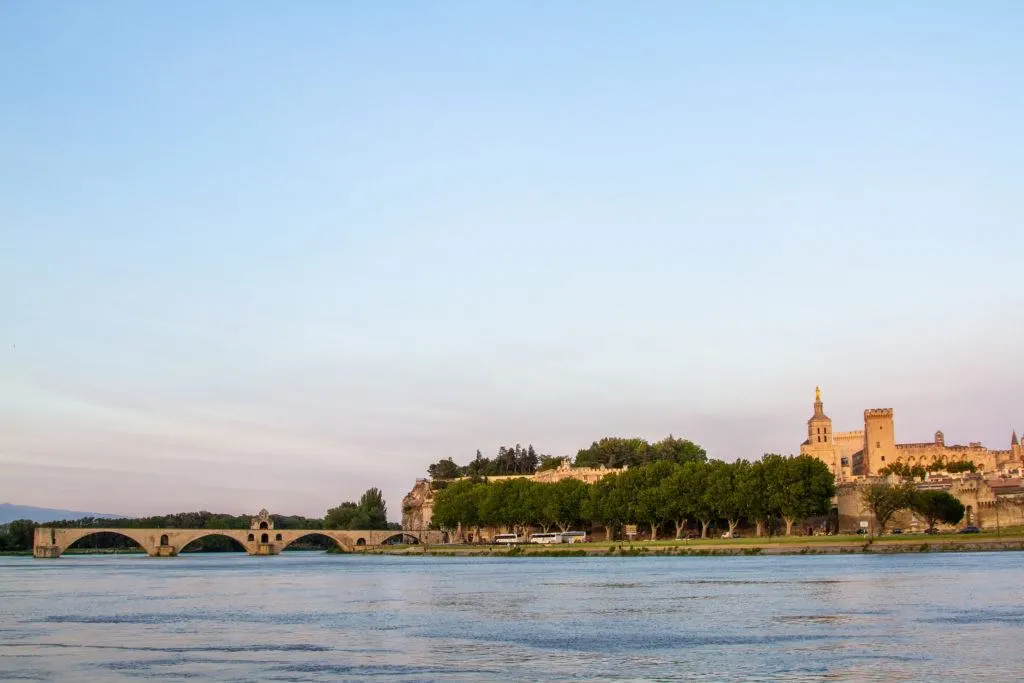
WHS #228 – Historic Centre of Avignon: Papal Palace, Episcopal Ensemble and Avignon Bridge
I’ve been to Avignon a couple of times. It’s a great place to stop a day or two. Visiting the world heritage sites are definitely the most important things to do, but the city is vibrant and fun as well.
Why is this a papal palace? I only thought there was one, and that is in the Vatican. However, there was a brief hundred years that there were multiple popes claiming they were the rightful ones. There was, of course, the ones in the Vatican, but there were also the ones that took up residency in the Papal Palace of Avignon.
Built by two popes, Pope Clement V and Pope John the XXII, these ornate and well guarded palaces were home to seven popes. The Great Schism lasted from 1378 to 1417.
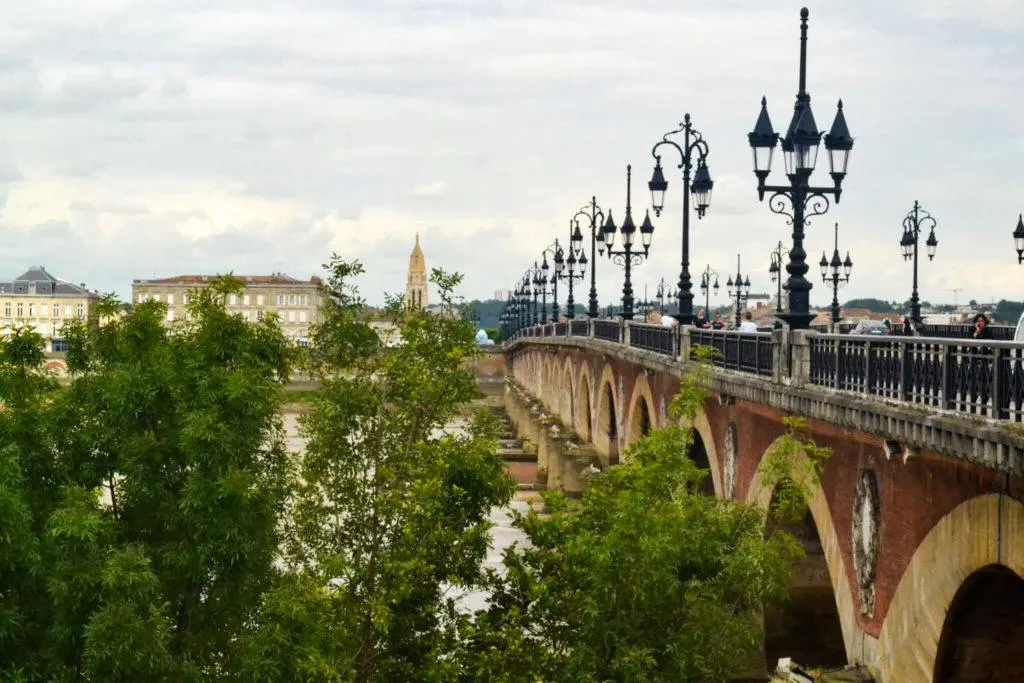
WHS #1256 – Bordeaux, Port of the Moon
By Shireen of The Happy Days Travels
Bordeaux, Port of the Moon, is an entire city given the privilege of being a World Heritage Site. Bordeaux is historical, a wine haven and the landscape is aesthetically pleasing. I have friends living in Bordeaux who kindly hosted me for a weekend and I was lucky to have a locally-guided tour of this city. I visited in June and being located in South West France, the weather was gorgeous and the evenings were a delight.
The city has a unique feel with dozens of listed buildings, each and every one worth visiting for its history, story, charm or architecture. The city scape is low-rising, wrapped up by the crescent-shaped River Garonne (which gave the city the name ‘Port of the Moon’) and landmarked by Pont de Pierre. This bridge was commissioned by Napoleon and, he gave an arch to every letter of his full name, so there are 17 arches as part of the bridge.
I saw many families, dogs, locals and tourists on my trip so the city is friendly for all types of travellers. Bordeaux is a master at wine and you can’t come to this World Heritage Site without indulging in some bread, cheese and wine. My top recommendations are to visit Place de la Bourse at night and the reflection pool in its courtyard, go to a local market for oysters and white wine, and eat duck in one of the many restaurants found around the city, and of course, snap a shot under the Grosse Cloche.
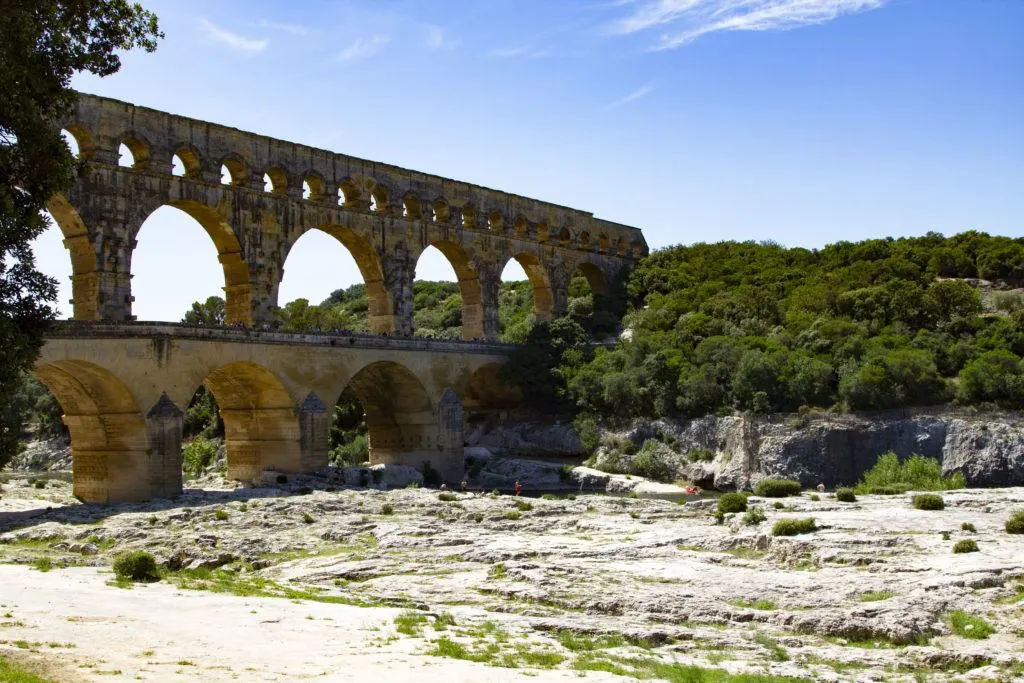
WHS #344 – Pont du Gard (Roman Aqueduct)
One of my best memories in France is the time we visited the Pont du Gard. I remember being completely amazed the first time this massive, tall aqueduct came into view. The sheer beauty of the bridge and aqueduct spanning the river valley, reflecting off the cool blue slow flowing water of the Gardon river was just magical. If I only had a swimsuit, I would have jumped right in the water and joined others swimming and floating under the Roman structure.
On that visit, at least, we had to settle for taking off shoes and socks, rolling up our pant legs, and dipping our feet in the water. Sitting under the shadow of the aqueduct was so peaceful, even when little fish came up and nibbled our toes. Aside from enjoying the view and the cool refreshing river, the site has a world class museum complete with a children’s interactive area.
Children can explore the history of the aqueduct and the Roman era in France, as well as learning about hydraulics and the engineering involved in building such a tall structure. In fact, Pont du Gard is the tallest Roman construction still in existence. Designed to carry water from the springs in Uzes to the fountains, baths and villas of Nimes, the aqueduct ran a meandering course of about 50 kilometers. As with other World Heritage sites in France, Napoleon gets the credit for restoring and ensuring the Pont du Gard aqueduct and bridge is still there to amaze us today.
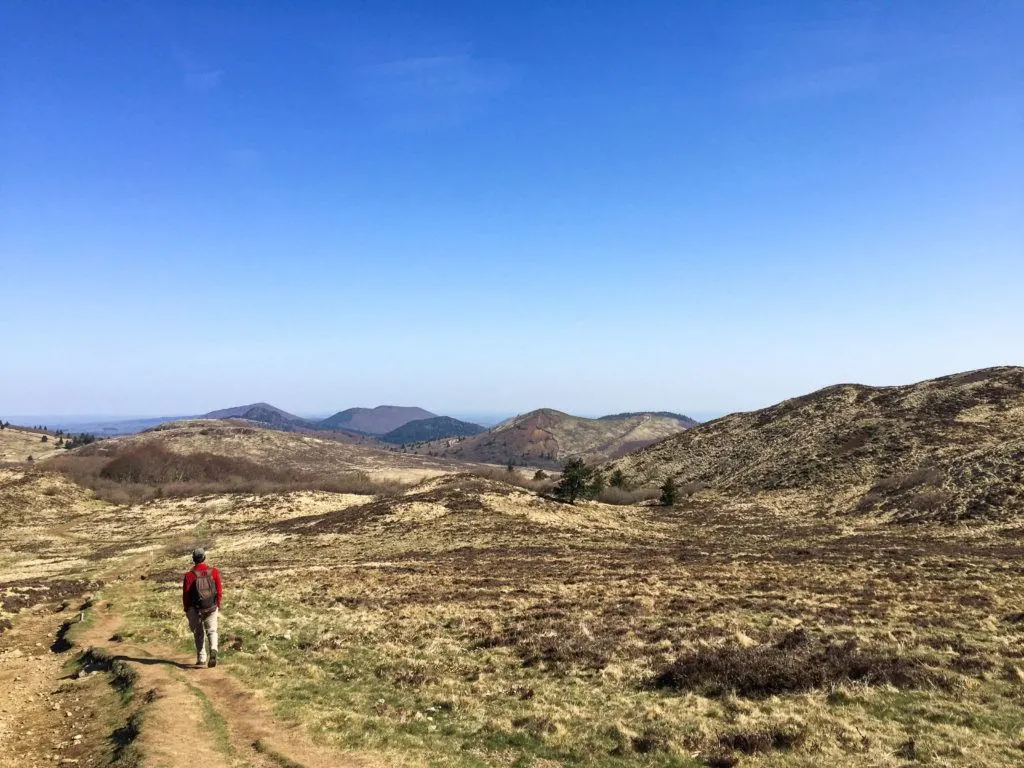
WHS #1434 – Chaîne des Puys – Limagne Fault Tectonic Arena
By Patricia of Ze Wandering Frogs
The region of Auvergne is close to our heart as this is my husband’s home region and half of my family ancestry. Most people would think about the Alps first when thinking about mountain ranges in France, but the Auvergne Chaîne des Puys – Limagne offers wonderful landscapes, whether in winter or summer. The famous fault tectonic arena has been recognized as a natural UNESCO World Heritage Site since 2018, a testament to the unique scenery.
One of the top activities is hiking in the popular Volcanoes Regional Nature Park covering the Chaîne des Puys, especially the iconic Puy-de-Dôme from where we admired the views of Auvergne on several occasions. Paragliding and biking are two other exciting outdoor activities adventure seekers can enjoy as well.
But the region is more than a beautiful place. It is also home to ancient history going back to the Romans, with historical sites like the Romanesque Basilica of Orcival, medieval Murol Castle, and quaint villages like Saint-Saturnin. Clermont-Ferrand, Auvergne’s main city, is known for its 13th-century Notre-Dame-de-l’Assomption Cathedral and makes for a great travel destination. And don’t forget Auvergne cuisine and cheese; you are in for a treat!
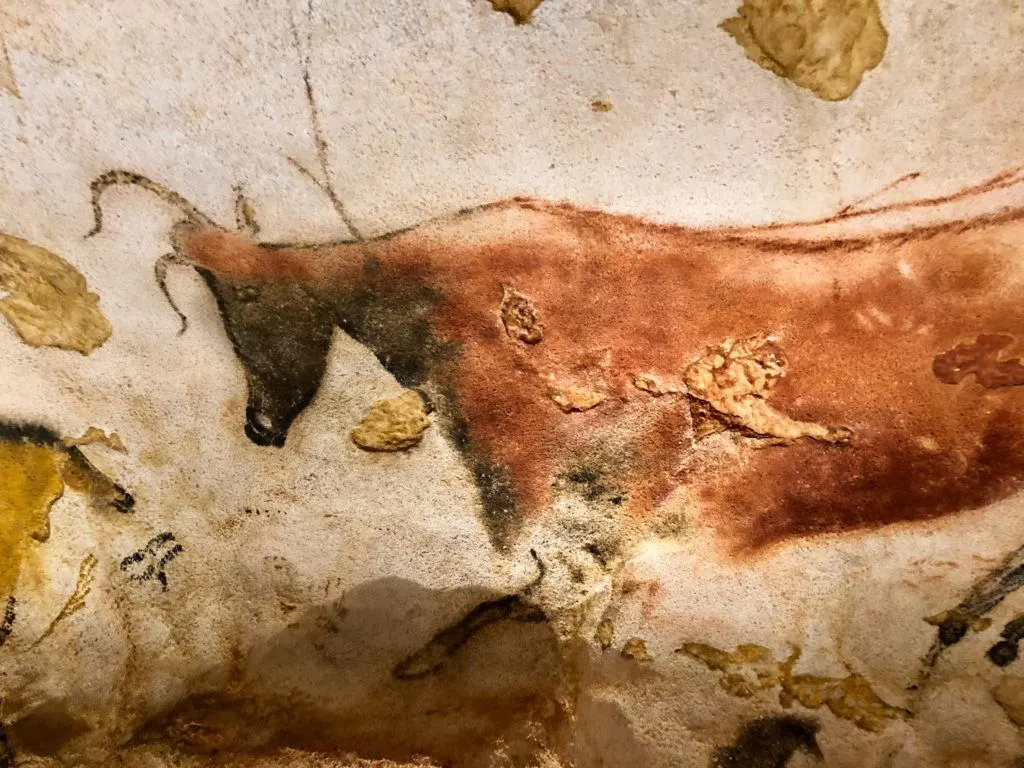
WHS #85 – Prehistoric Sites and Decorated Caves of the Vézère Valley
By Erica of Trip Scholars
A top destination for anyone interested in early man, archeology, or art history is the UNESCO World Heritage Site in the Dordogne: The Prehistoric Sites and Decorated Caves of the Vézère Valley. It is composed of fifteen significant prehistoric caves and shelters in the region. There are many remarkable locations included in the site: one dates to 400,000 years ago, another is the cave shelter Cro-magnon was named after, three are namesakes for entire prehistoric periods, and many include world-class prehistoric artwork.
Because of our deep interest in archeology and art history, we spent much of the preceding year learning before our trip to the Dordogne. Seeing these sites with this rich understanding made our experiences in the caves profound and so memorable that we still often talk about our visit. I was brought to tears repeatedly seeing what talented artists of the deep past were able to create. Some of the animal depictions convey powerful movement and intensity, while others are exceptionally tender and reverent. Beholding them in person intensified our appreciation of the people and cultures that created them.
Twelve of the sites still allow visitors, but tickets to some of the decorated caves can be very difficult to get, and it’s best to take a tour. We purchased our tickets to Lascaux IV (the reproduction of the adjacent original cave) in advance and I recommend others do the same. Tickets to the Cro-Magnon site can be purchased on arrival since this is a surprisingly uncrowded destination. The reproduction of Lascaux, also known as the Sistine Chapel of Prehistory, is a family-friendly, multimedia exhibit. Another great choice for families is Rouffingnac, which brings visitors deep into the cave on an electric train.
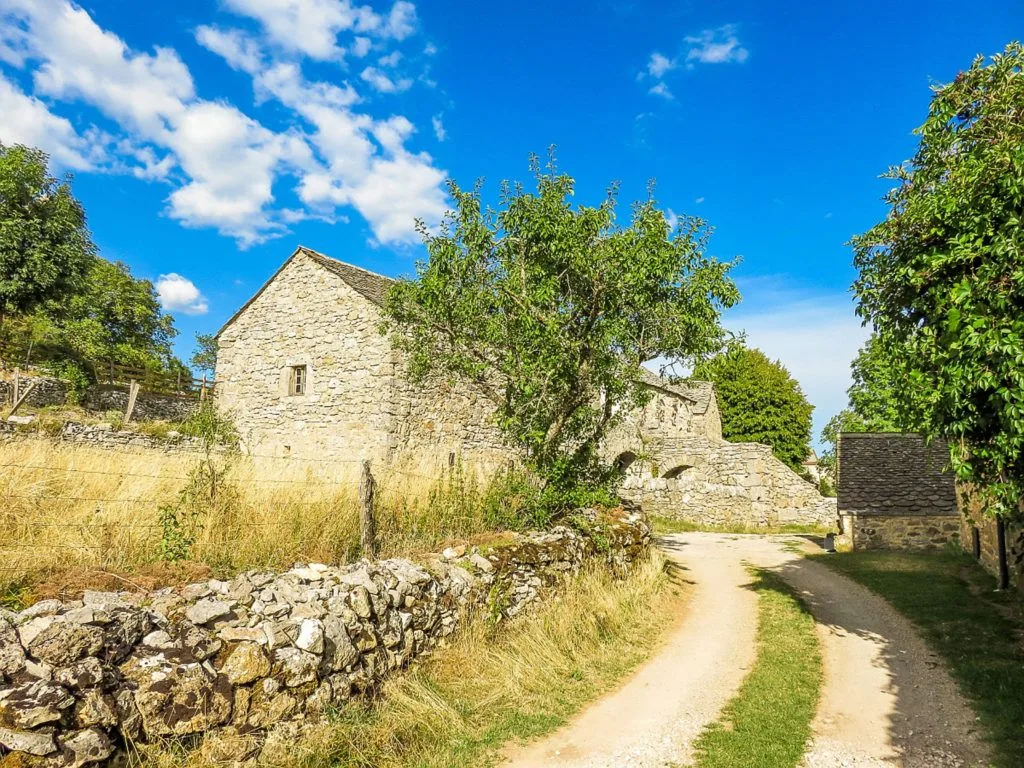
WHS #1153 – The Causses and the Cévennes, Mediterranean Agro-pastoral Cultural Landscape
By Daniela of Ipanema Travels
We were driving the Tarn Gorge downstream and at Les Vignes we took D16 up to Causse Méjean. The landscape changed drastically. Gone was the drama of the canyon with the hairpin bends, the vertical cliffs, hanging above our heads. Instead, we were driving through a somewhat melancholic area past small groves and grasslands. Nothing was suggesting that some 20 km further down the road we would reach the end of the plateau and would go into another rollercoaster of hairpin bends all the way down to the canyon of La Jonte River.
We were crossing the heart of the Causses and the Cévennes – a UNESCO World Heritage site in Southern France. You might think that the stunning nature is the reason why this place has made it to the renowned list, but actually it’s the interaction between humans and nature that is so important. The area is an excellent example of an agropastoral cultural landscape, and it is one of the few places where transhumance is still being practiced. Transhumance is the seasonal migration of livestock, and the people who tend them, between lowlands and adjacent mountains (source).
The Causses and the Cévennes is comprised of two large areas: Les Grands Causses – a regional park of high plateaus cut by river gorges, and Les Cévennes – a national park and a biosphere reserve. There are numerous hiking trails in the area and on the Tarn River you can do canoeing. I highly recommend also visiting the ecomuseum Ferme Caussenarde d’Autrefois. The adorable medieval villages like Sainte-Enimie, La Malene, Saint-Chély-du-Tarn, Peyreleau, to name just a few, are also a must-visit.
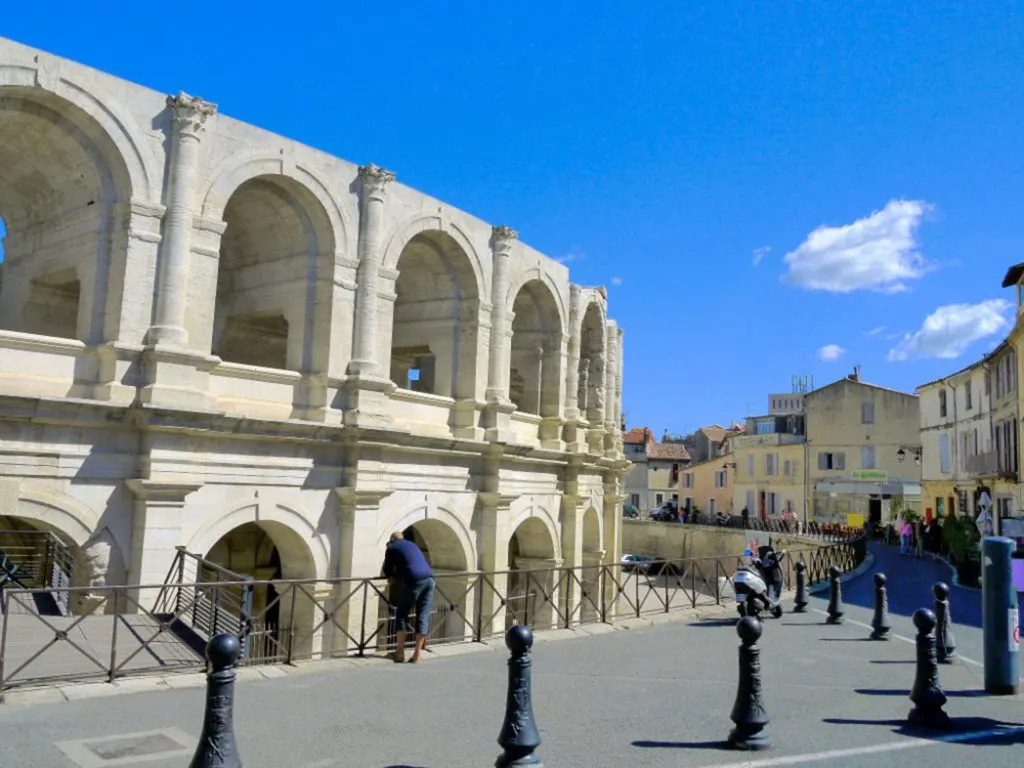
WHS #164 – Arles, Roman and Romanesque Monuments
By Casandra of Karpiak Caravan Adventure Family Travel
The city of Arles in southern France has been designated a UNESCO World Heritage Site and is one of the most important Roman sites in Europe. It’s also home to some amazing art museums with collections spanning from antiquity to modern day. Arles has been recognized as one of France’s most beautiful towns with its well-preserved Roman ruins, medieval streets and Romanesque churches.
A visit to this historic town will be both educational and enjoyable! Arles is easily accessible from many surrounding towns if you are planning a day trip there. Marseille, Avignon, Montpellier, Nimes are all nearby just to name a few.
Arles has a rich history that dates back to pre-Roman times and includes its Roman period as well as an early Christian era. As you walk through the streets and explore the buildings you’ll find many examples of Romanesque architecture. You can also take in some beautiful views from the Montmajour hilltop.
You’ll find that it’s easy to spend at least two days exploring all that Arles has to offer – but you may not want to leave. The sites that you must see while in Arles are the Amphithéâtre Romain (Arènes d’Arles),Les Alyscamps (Elysian Fields), Cloître Saint-Trophime, Théâtre Antique, the Van Gogh Self-Guided Walking Tour and of course Place de la République.
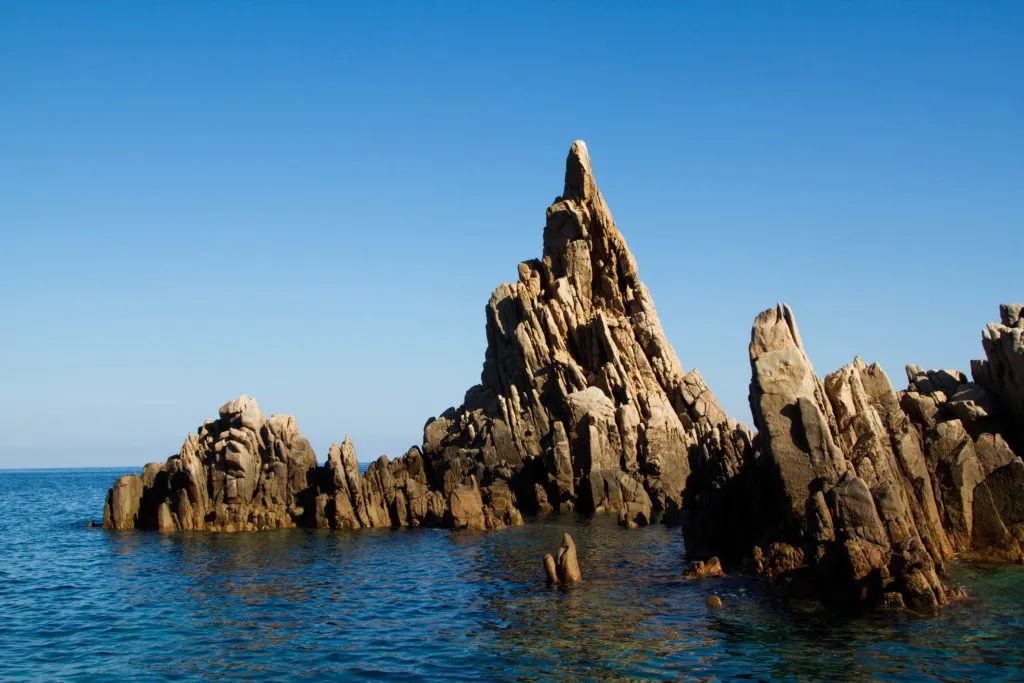
WHS #258 – Gulf of Porto: Calanche of Piana, Gulf of Girolata, Scandola Reserve
Some of the nature world heritage sites are my favorites. One summer, Jim and I had a little extra time for a trip before school started. We looked at the map and decided to take a ferry from Genoa to Corsica. We didn’t make any reservations, and we decided instead of staying in hotels, we’d camp. We packed the jeep and we were off.
We did virtually no planning, but along the way, we found out that one of the prettiest sites in France was on Corsica, the Scandola Nature Reserve. So, the second day we were there, we drove over to Porto Ota, on the western coast of Corsica to see it.
The site is inscribed because of the amazing “porphyritic rock mass,” in other words igneous rocks. The red rhyolite rocks are distinctive. Some look like they are piled on one another, but many look like prisms, lined up and pointing to the sky very similar to the basalt columns of the Giant’s Causeway in Northern Ireland.
The Scandola Nature Reserve is only accessible by foot or by boat, and if you go by foot, you will be climbing some serious mountains. Most people, us included, went by boat tour. What we did is just show up mid-morning in Porto. Boats go out all day long, and we just found the next small boat going out that day, paid our fee, and voilà, we were on our way.
The rock formations both on the land and in the sea were pretty amazing and varied. The coastline swerved into inlets with caves and arches. The entire day, we looked and marveled at them and never got tired of it. We almost booked again for the next day, but we decided to see more of the island instead.
Conclusion
Very few countries have as many UNESCO World Heritage Sites as France. Hopefully our list of these twenty-nine French WHS sites will help you plan your next adventure. There’s still more to go, so we’ll update our list in the future.
Author Bio: Corinne Vail is a travel photographer, food lover, and a perpetual traveler who has been travel writing for over 14 years. For many years she lived overseas in Germany, Japan, Turkey, South Korea, and the Netherlands teaching the children of the US. military. She’s visited over 90 countries, and she’s not stopping anytime soon.

